Information System Development Project for Retail Organization
VerifiedAdded on 2021/06/17
|26
|7418
|45
AI Summary
Contribute Materials
Your contribution can guide someone’s learning journey. Share your
documents today.
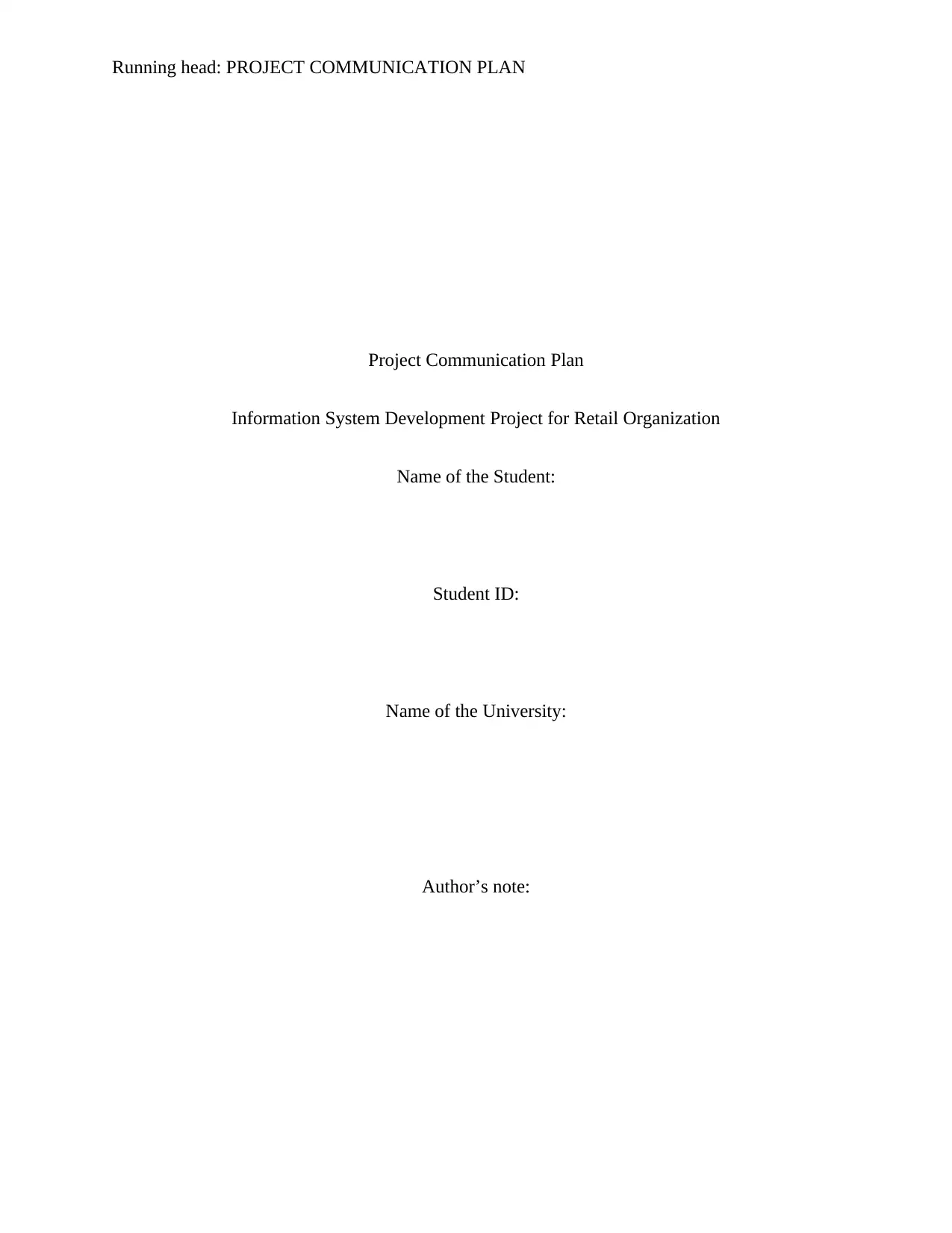
Running head: PROJECT COMMUNICATION PLAN
Project Communication Plan
Information System Development Project for Retail Organization
Name of the Student:
Student ID:
Name of the University:
Author’s note:
Project Communication Plan
Information System Development Project for Retail Organization
Name of the Student:
Student ID:
Name of the University:
Author’s note:
Secure Best Marks with AI Grader
Need help grading? Try our AI Grader for instant feedback on your assignments.
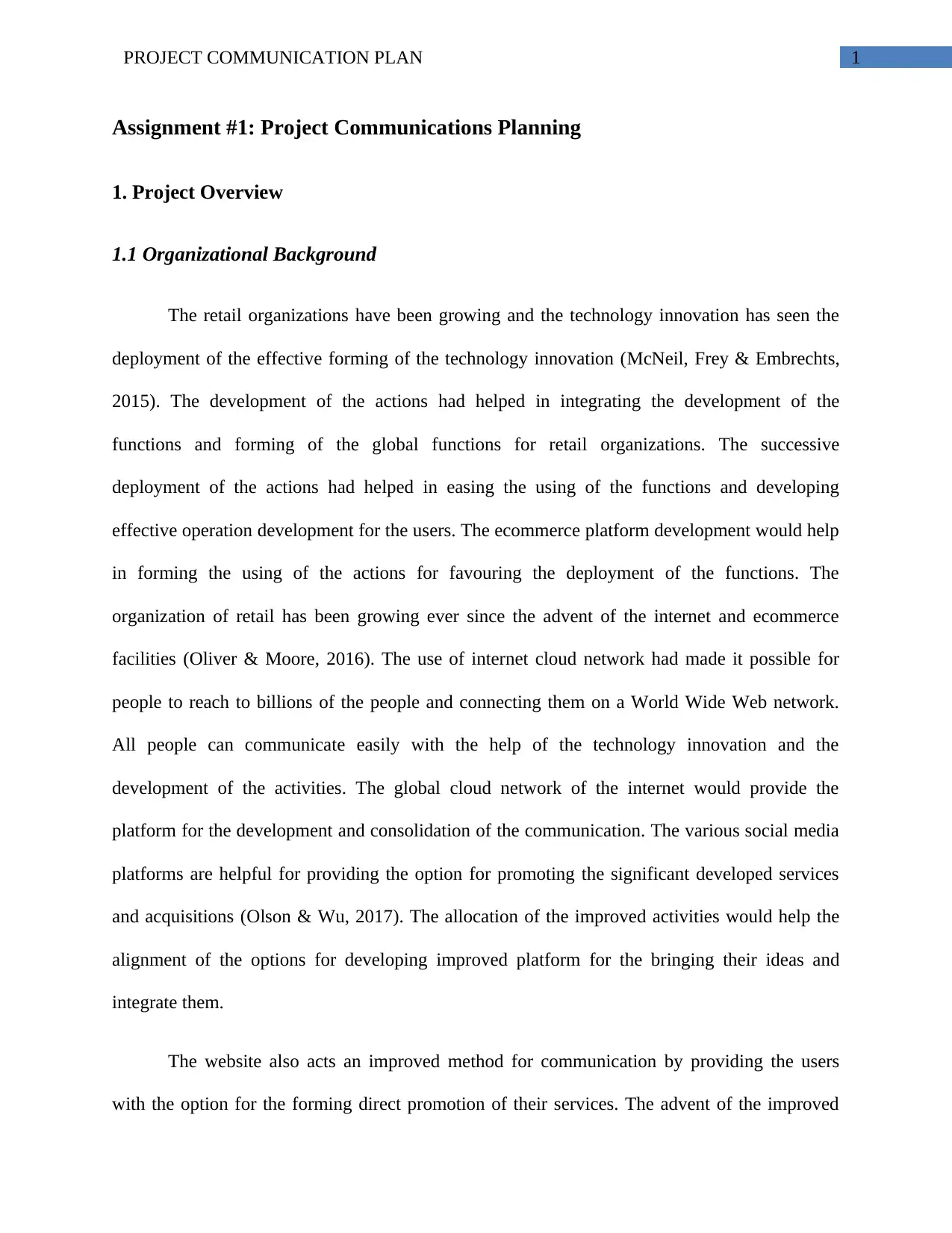
1PROJECT COMMUNICATION PLAN
Assignment #1: Project Communications Planning
1. Project Overview
1.1 Organizational Background
The retail organizations have been growing and the technology innovation has seen the
deployment of the effective forming of the technology innovation (McNeil, Frey & Embrechts,
2015). The development of the actions had helped in integrating the development of the
functions and forming of the global functions for retail organizations. The successive
deployment of the actions had helped in easing the using of the functions and developing
effective operation development for the users. The ecommerce platform development would help
in forming the using of the actions for favouring the deployment of the functions. The
organization of retail has been growing ever since the advent of the internet and ecommerce
facilities (Oliver & Moore, 2016). The use of internet cloud network had made it possible for
people to reach to billions of the people and connecting them on a World Wide Web network.
All people can communicate easily with the help of the technology innovation and the
development of the activities. The global cloud network of the internet would provide the
platform for the development and consolidation of the communication. The various social media
platforms are helpful for providing the option for promoting the significant developed services
and acquisitions (Olson & Wu, 2017). The allocation of the improved activities would help the
alignment of the options for developing improved platform for the bringing their ideas and
integrate them.
The website also acts an improved method for communication by providing the users
with the option for the forming direct promotion of their services. The advent of the improved
Assignment #1: Project Communications Planning
1. Project Overview
1.1 Organizational Background
The retail organizations have been growing and the technology innovation has seen the
deployment of the effective forming of the technology innovation (McNeil, Frey & Embrechts,
2015). The development of the actions had helped in integrating the development of the
functions and forming of the global functions for retail organizations. The successive
deployment of the actions had helped in easing the using of the functions and developing
effective operation development for the users. The ecommerce platform development would help
in forming the using of the actions for favouring the deployment of the functions. The
organization of retail has been growing ever since the advent of the internet and ecommerce
facilities (Oliver & Moore, 2016). The use of internet cloud network had made it possible for
people to reach to billions of the people and connecting them on a World Wide Web network.
All people can communicate easily with the help of the technology innovation and the
development of the activities. The global cloud network of the internet would provide the
platform for the development and consolidation of the communication. The various social media
platforms are helpful for providing the option for promoting the significant developed services
and acquisitions (Olson & Wu, 2017). The allocation of the improved activities would help the
alignment of the options for developing improved platform for the bringing their ideas and
integrate them.
The website also acts an improved method for communication by providing the users
with the option for the forming direct promotion of their services. The advent of the improved
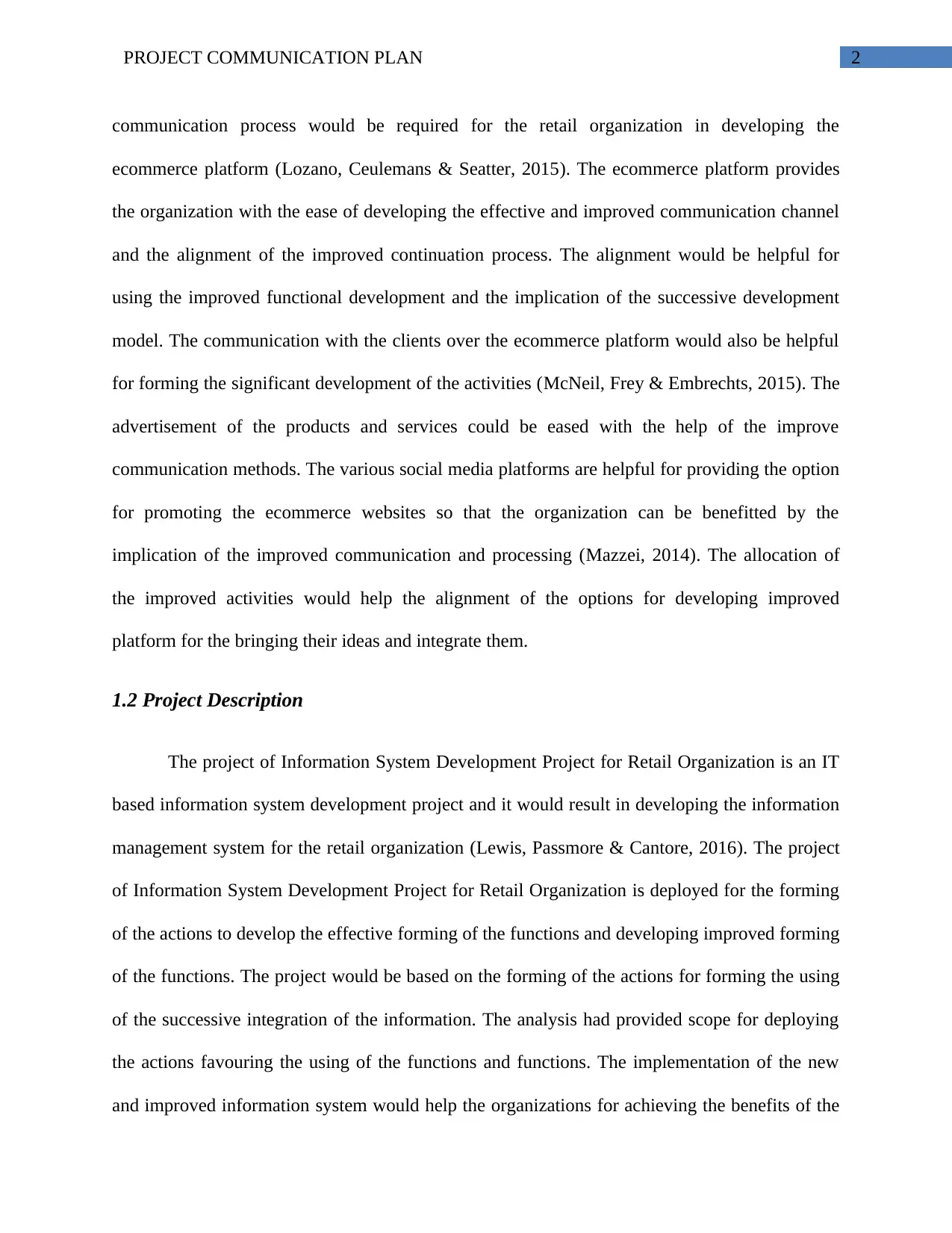
2PROJECT COMMUNICATION PLAN
communication process would be required for the retail organization in developing the
ecommerce platform (Lozano, Ceulemans & Seatter, 2015). The ecommerce platform provides
the organization with the ease of developing the effective and improved communication channel
and the alignment of the improved continuation process. The alignment would be helpful for
using the improved functional development and the implication of the successive development
model. The communication with the clients over the ecommerce platform would also be helpful
for forming the significant development of the activities (McNeil, Frey & Embrechts, 2015). The
advertisement of the products and services could be eased with the help of the improve
communication methods. The various social media platforms are helpful for providing the option
for promoting the ecommerce websites so that the organization can be benefitted by the
implication of the improved communication and processing (Mazzei, 2014). The allocation of
the improved activities would help the alignment of the options for developing improved
platform for the bringing their ideas and integrate them.
1.2 Project Description
The project of Information System Development Project for Retail Organization is an IT
based information system development project and it would result in developing the information
management system for the retail organization (Lewis, Passmore & Cantore, 2016). The project
of Information System Development Project for Retail Organization is deployed for the forming
of the actions to develop the effective forming of the functions and developing improved forming
of the functions. The project would be based on the forming of the actions for forming the using
of the successive integration of the information. The analysis had provided scope for deploying
the actions favouring the using of the functions and functions. The implementation of the new
and improved information system would help the organizations for achieving the benefits of the
communication process would be required for the retail organization in developing the
ecommerce platform (Lozano, Ceulemans & Seatter, 2015). The ecommerce platform provides
the organization with the ease of developing the effective and improved communication channel
and the alignment of the improved continuation process. The alignment would be helpful for
using the improved functional development and the implication of the successive development
model. The communication with the clients over the ecommerce platform would also be helpful
for forming the significant development of the activities (McNeil, Frey & Embrechts, 2015). The
advertisement of the products and services could be eased with the help of the improve
communication methods. The various social media platforms are helpful for providing the option
for promoting the ecommerce websites so that the organization can be benefitted by the
implication of the improved communication and processing (Mazzei, 2014). The allocation of
the improved activities would help the alignment of the options for developing improved
platform for the bringing their ideas and integrate them.
1.2 Project Description
The project of Information System Development Project for Retail Organization is an IT
based information system development project and it would result in developing the information
management system for the retail organization (Lewis, Passmore & Cantore, 2016). The project
of Information System Development Project for Retail Organization is deployed for the forming
of the actions to develop the effective forming of the functions and developing improved forming
of the functions. The project would be based on the forming of the actions for forming the using
of the successive integration of the information. The analysis had provided scope for deploying
the actions favouring the using of the functions and functions. The implementation of the new
and improved information system would help the organizations for achieving the benefits of the
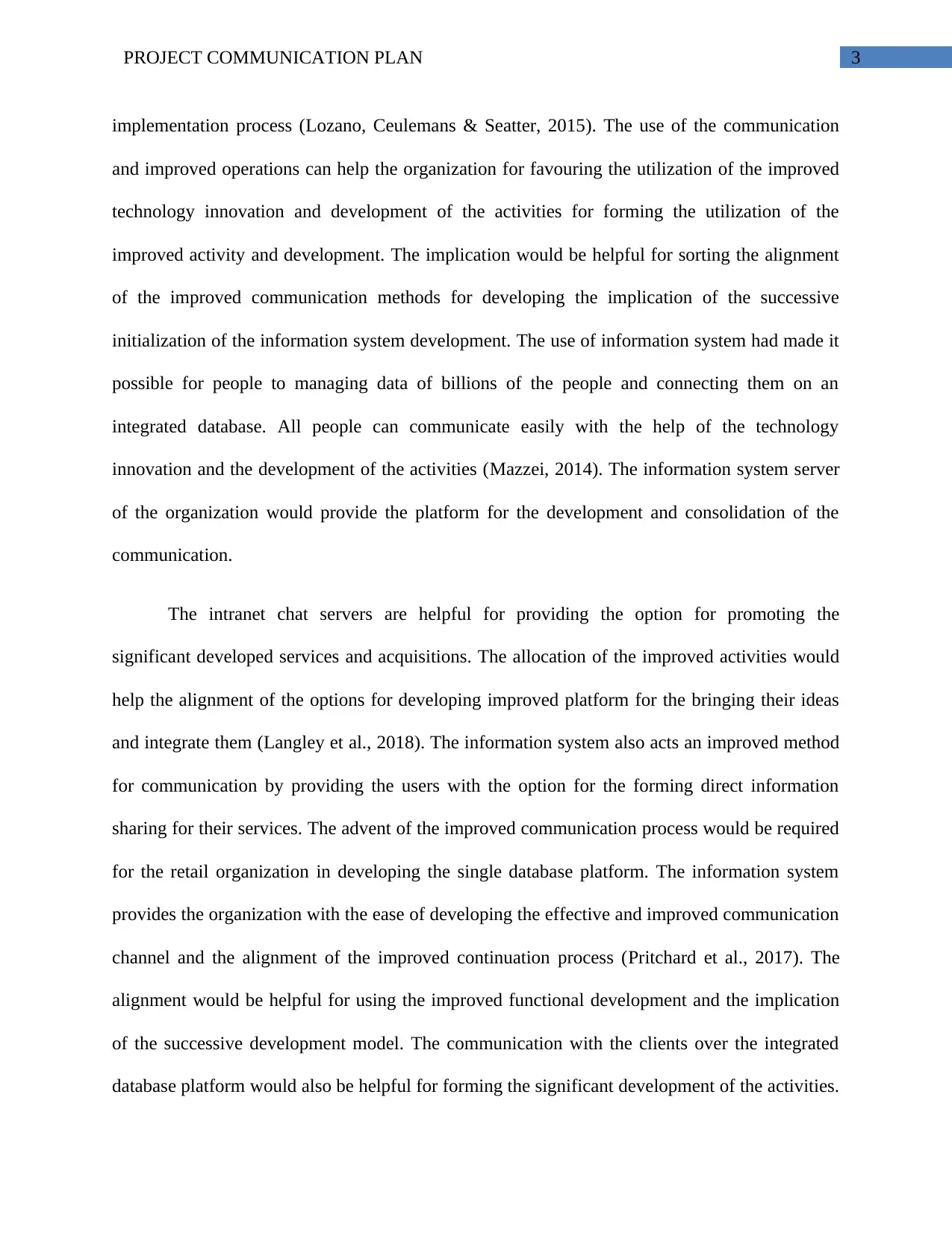
3PROJECT COMMUNICATION PLAN
implementation process (Lozano, Ceulemans & Seatter, 2015). The use of the communication
and improved operations can help the organization for favouring the utilization of the improved
technology innovation and development of the activities for forming the utilization of the
improved activity and development. The implication would be helpful for sorting the alignment
of the improved communication methods for developing the implication of the successive
initialization of the information system development. The use of information system had made it
possible for people to managing data of billions of the people and connecting them on an
integrated database. All people can communicate easily with the help of the technology
innovation and the development of the activities (Mazzei, 2014). The information system server
of the organization would provide the platform for the development and consolidation of the
communication.
The intranet chat servers are helpful for providing the option for promoting the
significant developed services and acquisitions. The allocation of the improved activities would
help the alignment of the options for developing improved platform for the bringing their ideas
and integrate them (Langley et al., 2018). The information system also acts an improved method
for communication by providing the users with the option for the forming direct information
sharing for their services. The advent of the improved communication process would be required
for the retail organization in developing the single database platform. The information system
provides the organization with the ease of developing the effective and improved communication
channel and the alignment of the improved continuation process (Pritchard et al., 2017). The
alignment would be helpful for using the improved functional development and the implication
of the successive development model. The communication with the clients over the integrated
database platform would also be helpful for forming the significant development of the activities.
implementation process (Lozano, Ceulemans & Seatter, 2015). The use of the communication
and improved operations can help the organization for favouring the utilization of the improved
technology innovation and development of the activities for forming the utilization of the
improved activity and development. The implication would be helpful for sorting the alignment
of the improved communication methods for developing the implication of the successive
initialization of the information system development. The use of information system had made it
possible for people to managing data of billions of the people and connecting them on an
integrated database. All people can communicate easily with the help of the technology
innovation and the development of the activities (Mazzei, 2014). The information system server
of the organization would provide the platform for the development and consolidation of the
communication.
The intranet chat servers are helpful for providing the option for promoting the
significant developed services and acquisitions. The allocation of the improved activities would
help the alignment of the options for developing improved platform for the bringing their ideas
and integrate them (Langley et al., 2018). The information system also acts an improved method
for communication by providing the users with the option for the forming direct information
sharing for their services. The advent of the improved communication process would be required
for the retail organization in developing the single database platform. The information system
provides the organization with the ease of developing the effective and improved communication
channel and the alignment of the improved continuation process (Pritchard et al., 2017). The
alignment would be helpful for using the improved functional development and the implication
of the successive development model. The communication with the clients over the integrated
database platform would also be helpful for forming the significant development of the activities.
Secure Best Marks with AI Grader
Need help grading? Try our AI Grader for instant feedback on your assignments.
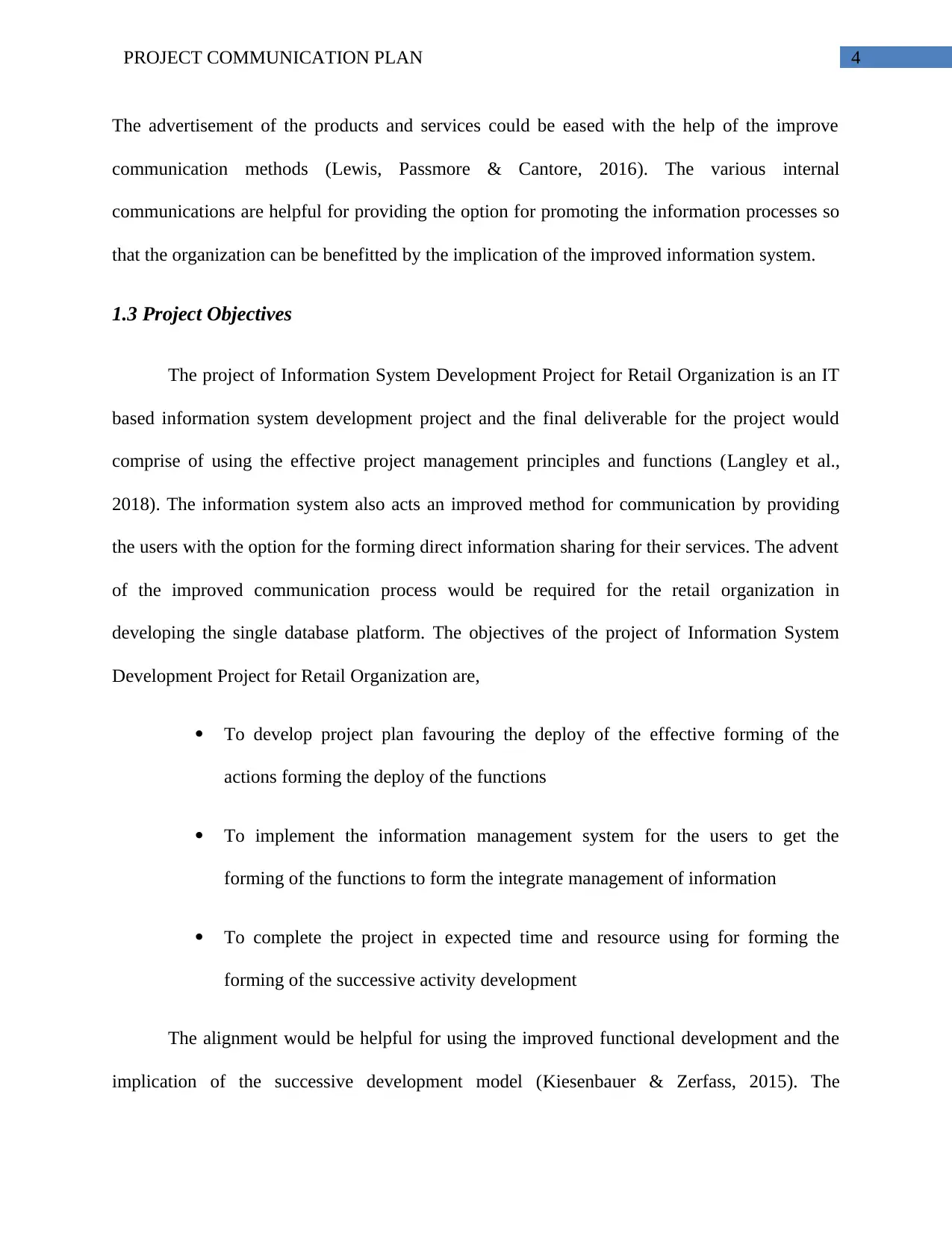
4PROJECT COMMUNICATION PLAN
The advertisement of the products and services could be eased with the help of the improve
communication methods (Lewis, Passmore & Cantore, 2016). The various internal
communications are helpful for providing the option for promoting the information processes so
that the organization can be benefitted by the implication of the improved information system.
1.3 Project Objectives
The project of Information System Development Project for Retail Organization is an IT
based information system development project and the final deliverable for the project would
comprise of using the effective project management principles and functions (Langley et al.,
2018). The information system also acts an improved method for communication by providing
the users with the option for the forming direct information sharing for their services. The advent
of the improved communication process would be required for the retail organization in
developing the single database platform. The objectives of the project of Information System
Development Project for Retail Organization are,
To develop project plan favouring the deploy of the effective forming of the
actions forming the deploy of the functions
To implement the information management system for the users to get the
forming of the functions to form the integrate management of information
To complete the project in expected time and resource using for forming the
forming of the successive activity development
The alignment would be helpful for using the improved functional development and the
implication of the successive development model (Kiesenbauer & Zerfass, 2015). The
The advertisement of the products and services could be eased with the help of the improve
communication methods (Lewis, Passmore & Cantore, 2016). The various internal
communications are helpful for providing the option for promoting the information processes so
that the organization can be benefitted by the implication of the improved information system.
1.3 Project Objectives
The project of Information System Development Project for Retail Organization is an IT
based information system development project and the final deliverable for the project would
comprise of using the effective project management principles and functions (Langley et al.,
2018). The information system also acts an improved method for communication by providing
the users with the option for the forming direct information sharing for their services. The advent
of the improved communication process would be required for the retail organization in
developing the single database platform. The objectives of the project of Information System
Development Project for Retail Organization are,
To develop project plan favouring the deploy of the effective forming of the
actions forming the deploy of the functions
To implement the information management system for the users to get the
forming of the functions to form the integrate management of information
To complete the project in expected time and resource using for forming the
forming of the successive activity development
The alignment would be helpful for using the improved functional development and the
implication of the successive development model (Kiesenbauer & Zerfass, 2015). The
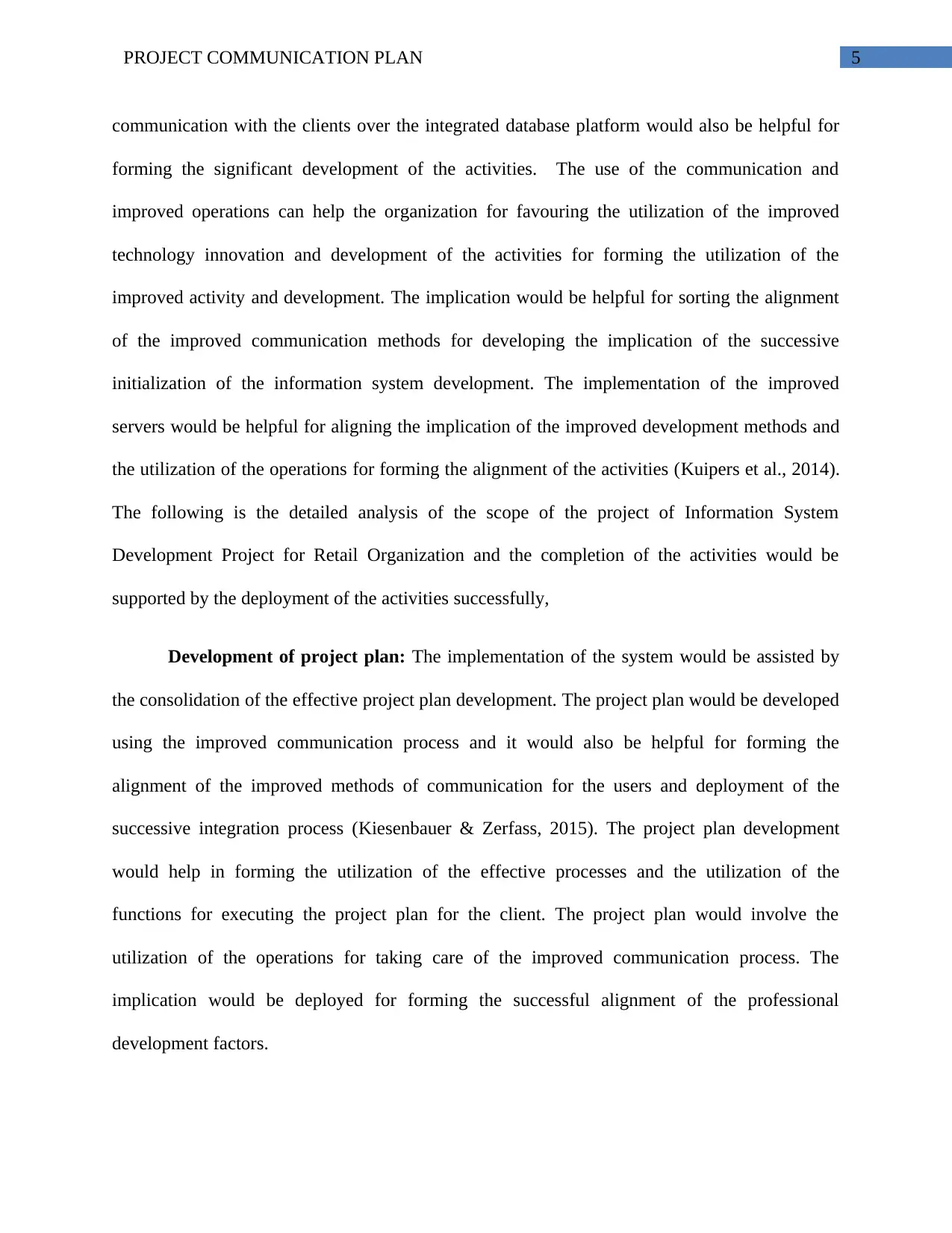
5PROJECT COMMUNICATION PLAN
communication with the clients over the integrated database platform would also be helpful for
forming the significant development of the activities. The use of the communication and
improved operations can help the organization for favouring the utilization of the improved
technology innovation and development of the activities for forming the utilization of the
improved activity and development. The implication would be helpful for sorting the alignment
of the improved communication methods for developing the implication of the successive
initialization of the information system development. The implementation of the improved
servers would be helpful for aligning the implication of the improved development methods and
the utilization of the operations for forming the alignment of the activities (Kuipers et al., 2014).
The following is the detailed analysis of the scope of the project of Information System
Development Project for Retail Organization and the completion of the activities would be
supported by the deployment of the activities successfully,
Development of project plan: The implementation of the system would be assisted by
the consolidation of the effective project plan development. The project plan would be developed
using the improved communication process and it would also be helpful for forming the
alignment of the improved methods of communication for the users and deployment of the
successive integration process (Kiesenbauer & Zerfass, 2015). The project plan development
would help in forming the utilization of the effective processes and the utilization of the
functions for executing the project plan for the client. The project plan would involve the
utilization of the operations for taking care of the improved communication process. The
implication would be deployed for forming the successful alignment of the professional
development factors.
communication with the clients over the integrated database platform would also be helpful for
forming the significant development of the activities. The use of the communication and
improved operations can help the organization for favouring the utilization of the improved
technology innovation and development of the activities for forming the utilization of the
improved activity and development. The implication would be helpful for sorting the alignment
of the improved communication methods for developing the implication of the successive
initialization of the information system development. The implementation of the improved
servers would be helpful for aligning the implication of the improved development methods and
the utilization of the operations for forming the alignment of the activities (Kuipers et al., 2014).
The following is the detailed analysis of the scope of the project of Information System
Development Project for Retail Organization and the completion of the activities would be
supported by the deployment of the activities successfully,
Development of project plan: The implementation of the system would be assisted by
the consolidation of the effective project plan development. The project plan would be developed
using the improved communication process and it would also be helpful for forming the
alignment of the improved methods of communication for the users and deployment of the
successive integration process (Kiesenbauer & Zerfass, 2015). The project plan development
would help in forming the utilization of the effective processes and the utilization of the
functions for executing the project plan for the client. The project plan would involve the
utilization of the operations for taking care of the improved communication process. The
implication would be deployed for forming the successful alignment of the professional
development factors.
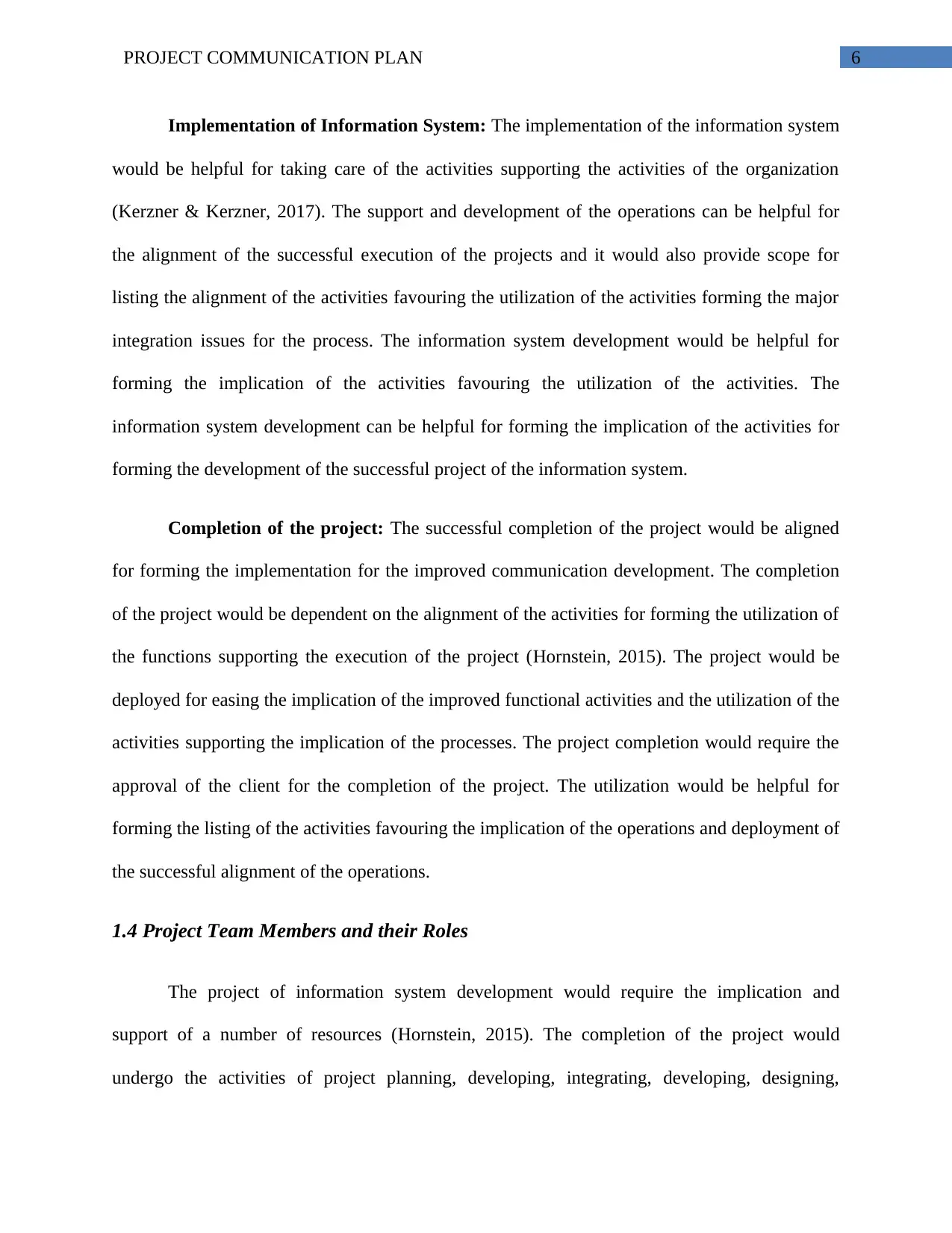
6PROJECT COMMUNICATION PLAN
Implementation of Information System: The implementation of the information system
would be helpful for taking care of the activities supporting the activities of the organization
(Kerzner & Kerzner, 2017). The support and development of the operations can be helpful for
the alignment of the successful execution of the projects and it would also provide scope for
listing the alignment of the activities favouring the utilization of the activities forming the major
integration issues for the process. The information system development would be helpful for
forming the implication of the activities favouring the utilization of the activities. The
information system development can be helpful for forming the implication of the activities for
forming the development of the successful project of the information system.
Completion of the project: The successful completion of the project would be aligned
for forming the implementation for the improved communication development. The completion
of the project would be dependent on the alignment of the activities for forming the utilization of
the functions supporting the execution of the project (Hornstein, 2015). The project would be
deployed for easing the implication of the improved functional activities and the utilization of the
activities supporting the implication of the processes. The project completion would require the
approval of the client for the completion of the project. The utilization would be helpful for
forming the listing of the activities favouring the implication of the operations and deployment of
the successful alignment of the operations.
1.4 Project Team Members and their Roles
The project of information system development would require the implication and
support of a number of resources (Hornstein, 2015). The completion of the project would
undergo the activities of project planning, developing, integrating, developing, designing,
Implementation of Information System: The implementation of the information system
would be helpful for taking care of the activities supporting the activities of the organization
(Kerzner & Kerzner, 2017). The support and development of the operations can be helpful for
the alignment of the successful execution of the projects and it would also provide scope for
listing the alignment of the activities favouring the utilization of the activities forming the major
integration issues for the process. The information system development would be helpful for
forming the implication of the activities favouring the utilization of the activities. The
information system development can be helpful for forming the implication of the activities for
forming the development of the successful project of the information system.
Completion of the project: The successful completion of the project would be aligned
for forming the implementation for the improved communication development. The completion
of the project would be dependent on the alignment of the activities for forming the utilization of
the functions supporting the execution of the project (Hornstein, 2015). The project would be
deployed for easing the implication of the improved functional activities and the utilization of the
activities supporting the implication of the processes. The project completion would require the
approval of the client for the completion of the project. The utilization would be helpful for
forming the listing of the activities favouring the implication of the operations and deployment of
the successful alignment of the operations.
1.4 Project Team Members and their Roles
The project of information system development would require the implication and
support of a number of resources (Hornstein, 2015). The completion of the project would
undergo the activities of project planning, developing, integrating, developing, designing,
Paraphrase This Document
Need a fresh take? Get an instant paraphrase of this document with our AI Paraphraser
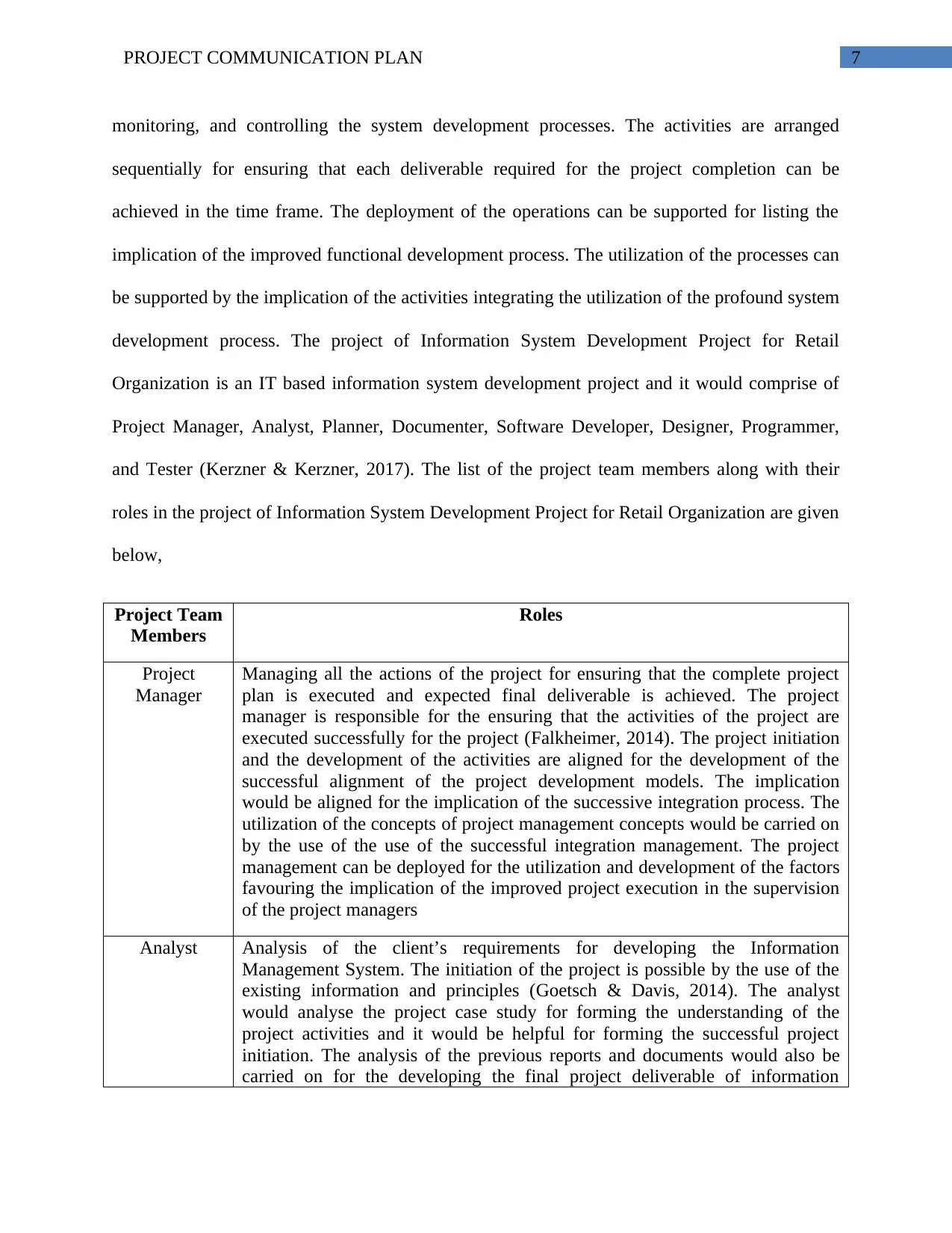
7PROJECT COMMUNICATION PLAN
monitoring, and controlling the system development processes. The activities are arranged
sequentially for ensuring that each deliverable required for the project completion can be
achieved in the time frame. The deployment of the operations can be supported for listing the
implication of the improved functional development process. The utilization of the processes can
be supported by the implication of the activities integrating the utilization of the profound system
development process. The project of Information System Development Project for Retail
Organization is an IT based information system development project and it would comprise of
Project Manager, Analyst, Planner, Documenter, Software Developer, Designer, Programmer,
and Tester (Kerzner & Kerzner, 2017). The list of the project team members along with their
roles in the project of Information System Development Project for Retail Organization are given
below,
Project Team
Members
Roles
Project
Manager
Managing all the actions of the project for ensuring that the complete project
plan is executed and expected final deliverable is achieved. The project
manager is responsible for the ensuring that the activities of the project are
executed successfully for the project (Falkheimer, 2014). The project initiation
and the development of the activities are aligned for the development of the
successful alignment of the project development models. The implication
would be aligned for the implication of the successive integration process. The
utilization of the concepts of project management concepts would be carried on
by the use of the use of the successful integration management. The project
management can be deployed for the utilization and development of the factors
favouring the implication of the improved project execution in the supervision
of the project managers
Analyst Analysis of the client’s requirements for developing the Information
Management System. The initiation of the project is possible by the use of the
existing information and principles (Goetsch & Davis, 2014). The analyst
would analyse the project case study for forming the understanding of the
project activities and it would be helpful for forming the successful project
initiation. The analysis of the previous reports and documents would also be
carried on for the developing the final project deliverable of information
monitoring, and controlling the system development processes. The activities are arranged
sequentially for ensuring that each deliverable required for the project completion can be
achieved in the time frame. The deployment of the operations can be supported for listing the
implication of the improved functional development process. The utilization of the processes can
be supported by the implication of the activities integrating the utilization of the profound system
development process. The project of Information System Development Project for Retail
Organization is an IT based information system development project and it would comprise of
Project Manager, Analyst, Planner, Documenter, Software Developer, Designer, Programmer,
and Tester (Kerzner & Kerzner, 2017). The list of the project team members along with their
roles in the project of Information System Development Project for Retail Organization are given
below,
Project Team
Members
Roles
Project
Manager
Managing all the actions of the project for ensuring that the complete project
plan is executed and expected final deliverable is achieved. The project
manager is responsible for the ensuring that the activities of the project are
executed successfully for the project (Falkheimer, 2014). The project initiation
and the development of the activities are aligned for the development of the
successful alignment of the project development models. The implication
would be aligned for the implication of the successive integration process. The
utilization of the concepts of project management concepts would be carried on
by the use of the use of the successful integration management. The project
management can be deployed for the utilization and development of the factors
favouring the implication of the improved project execution in the supervision
of the project managers
Analyst Analysis of the client’s requirements for developing the Information
Management System. The initiation of the project is possible by the use of the
existing information and principles (Goetsch & Davis, 2014). The analyst
would analyse the project case study for forming the understanding of the
project activities and it would be helpful for forming the successful project
initiation. The analysis of the previous reports and documents would also be
carried on for the developing the final project deliverable of information
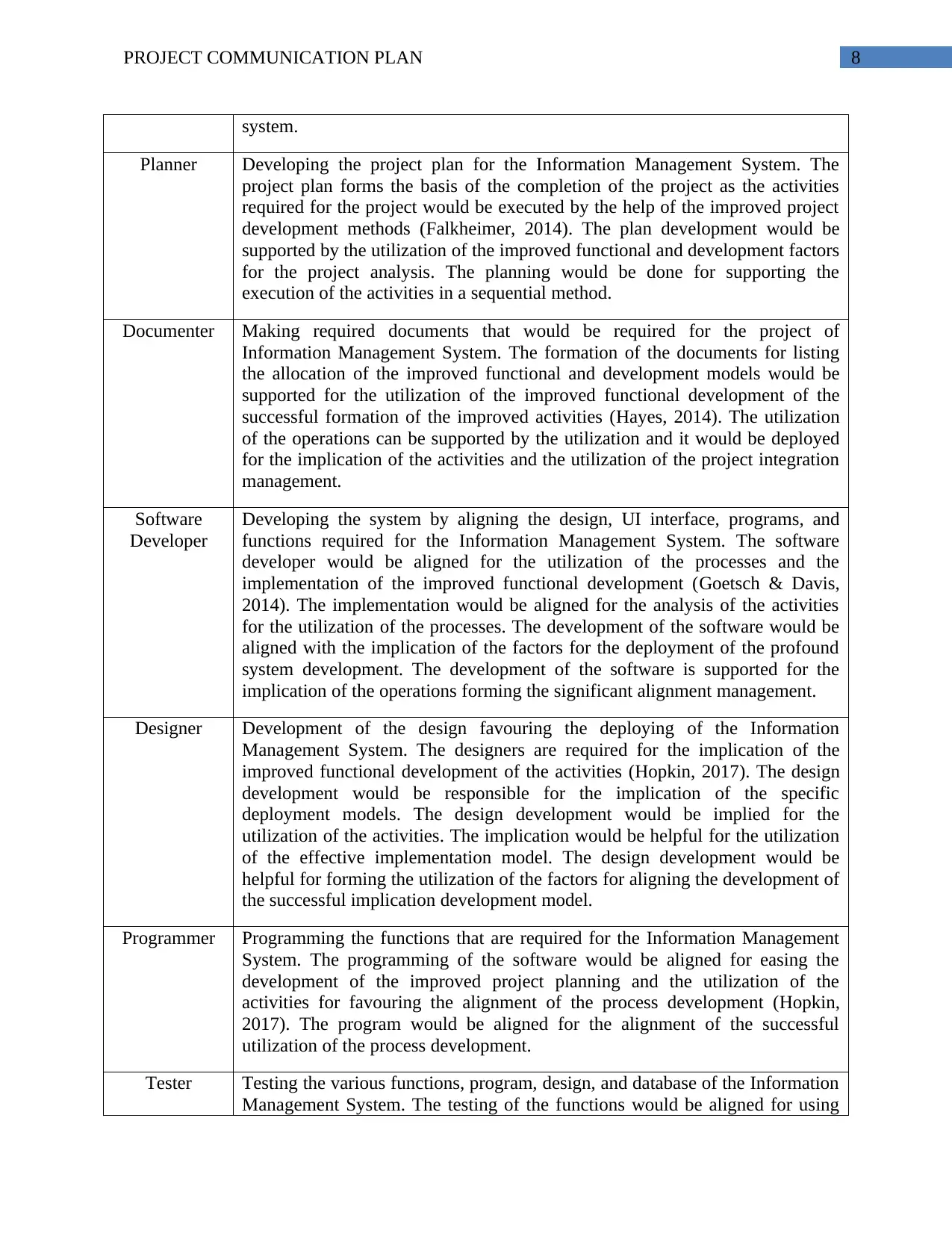
8PROJECT COMMUNICATION PLAN
system.
Planner Developing the project plan for the Information Management System. The
project plan forms the basis of the completion of the project as the activities
required for the project would be executed by the help of the improved project
development methods (Falkheimer, 2014). The plan development would be
supported by the utilization of the improved functional and development factors
for the project analysis. The planning would be done for supporting the
execution of the activities in a sequential method.
Documenter Making required documents that would be required for the project of
Information Management System. The formation of the documents for listing
the allocation of the improved functional and development models would be
supported for the utilization of the improved functional development of the
successful formation of the improved activities (Hayes, 2014). The utilization
of the operations can be supported by the utilization and it would be deployed
for the implication of the activities and the utilization of the project integration
management.
Software
Developer
Developing the system by aligning the design, UI interface, programs, and
functions required for the Information Management System. The software
developer would be aligned for the utilization of the processes and the
implementation of the improved functional development (Goetsch & Davis,
2014). The implementation would be aligned for the analysis of the activities
for the utilization of the processes. The development of the software would be
aligned with the implication of the factors for the deployment of the profound
system development. The development of the software is supported for the
implication of the operations forming the significant alignment management.
Designer Development of the design favouring the deploying of the Information
Management System. The designers are required for the implication of the
improved functional development of the activities (Hopkin, 2017). The design
development would be responsible for the implication of the specific
deployment models. The design development would be implied for the
utilization of the activities. The implication would be helpful for the utilization
of the effective implementation model. The design development would be
helpful for forming the utilization of the factors for aligning the development of
the successful implication development model.
Programmer Programming the functions that are required for the Information Management
System. The programming of the software would be aligned for easing the
development of the improved project planning and the utilization of the
activities for favouring the alignment of the process development (Hopkin,
2017). The program would be aligned for the alignment of the successful
utilization of the process development.
Tester Testing the various functions, program, design, and database of the Information
Management System. The testing of the functions would be aligned for using
system.
Planner Developing the project plan for the Information Management System. The
project plan forms the basis of the completion of the project as the activities
required for the project would be executed by the help of the improved project
development methods (Falkheimer, 2014). The plan development would be
supported by the utilization of the improved functional and development factors
for the project analysis. The planning would be done for supporting the
execution of the activities in a sequential method.
Documenter Making required documents that would be required for the project of
Information Management System. The formation of the documents for listing
the allocation of the improved functional and development models would be
supported for the utilization of the improved functional development of the
successful formation of the improved activities (Hayes, 2014). The utilization
of the operations can be supported by the utilization and it would be deployed
for the implication of the activities and the utilization of the project integration
management.
Software
Developer
Developing the system by aligning the design, UI interface, programs, and
functions required for the Information Management System. The software
developer would be aligned for the utilization of the processes and the
implementation of the improved functional development (Goetsch & Davis,
2014). The implementation would be aligned for the analysis of the activities
for the utilization of the processes. The development of the software would be
aligned with the implication of the factors for the deployment of the profound
system development. The development of the software is supported for the
implication of the operations forming the significant alignment management.
Designer Development of the design favouring the deploying of the Information
Management System. The designers are required for the implication of the
improved functional development of the activities (Hopkin, 2017). The design
development would be responsible for the implication of the specific
deployment models. The design development would be implied for the
utilization of the activities. The implication would be helpful for the utilization
of the effective implementation model. The design development would be
helpful for forming the utilization of the factors for aligning the development of
the successful implication development model.
Programmer Programming the functions that are required for the Information Management
System. The programming of the software would be aligned for easing the
development of the improved project planning and the utilization of the
activities for favouring the alignment of the process development (Hopkin,
2017). The program would be aligned for the alignment of the successful
utilization of the process development.
Tester Testing the various functions, program, design, and database of the Information
Management System. The testing of the functions would be aligned for using
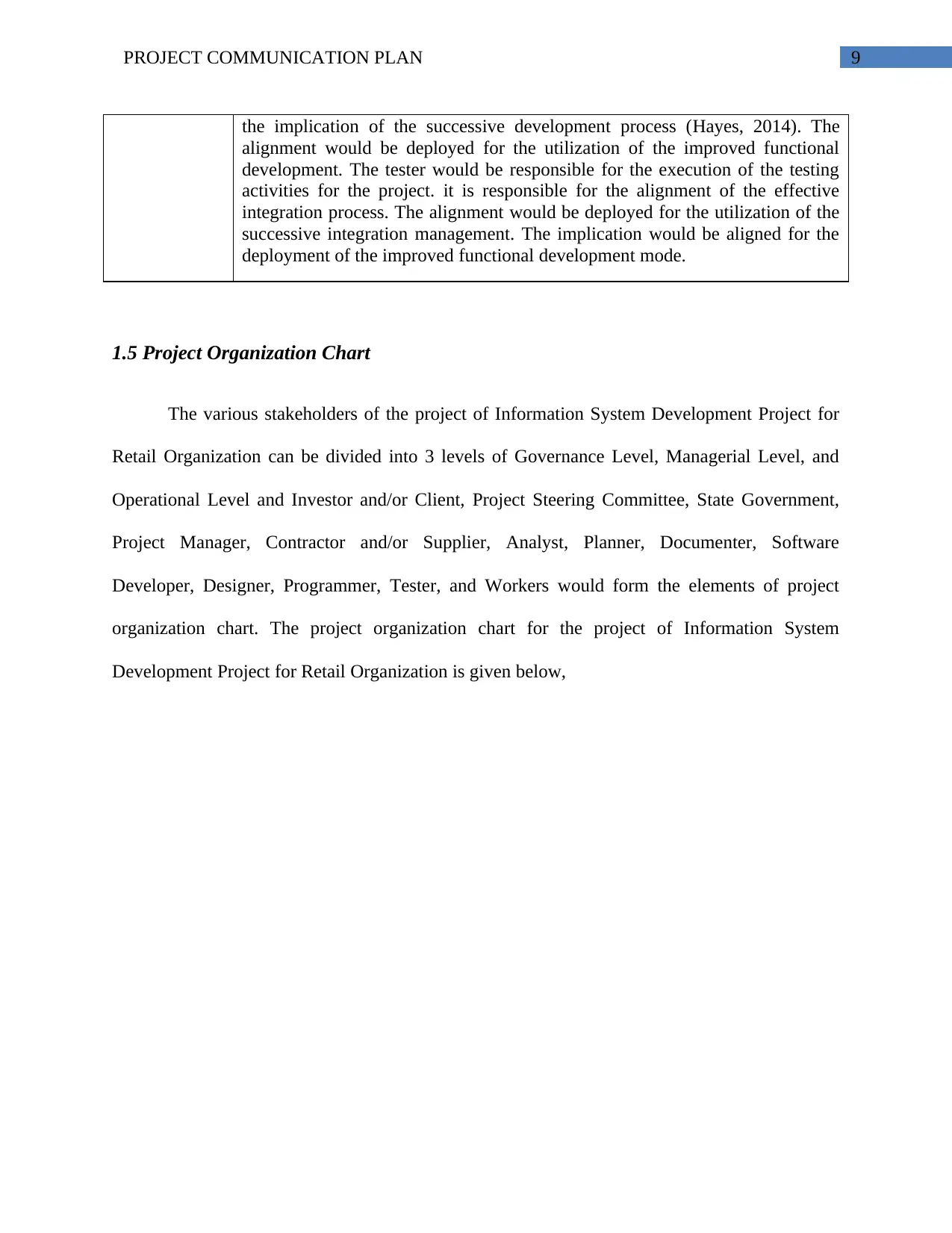
9PROJECT COMMUNICATION PLAN
the implication of the successive development process (Hayes, 2014). The
alignment would be deployed for the utilization of the improved functional
development. The tester would be responsible for the execution of the testing
activities for the project. it is responsible for the alignment of the effective
integration process. The alignment would be deployed for the utilization of the
successive integration management. The implication would be aligned for the
deployment of the improved functional development mode.
1.5 Project Organization Chart
The various stakeholders of the project of Information System Development Project for
Retail Organization can be divided into 3 levels of Governance Level, Managerial Level, and
Operational Level and Investor and/or Client, Project Steering Committee, State Government,
Project Manager, Contractor and/or Supplier, Analyst, Planner, Documenter, Software
Developer, Designer, Programmer, Tester, and Workers would form the elements of project
organization chart. The project organization chart for the project of Information System
Development Project for Retail Organization is given below,
the implication of the successive development process (Hayes, 2014). The
alignment would be deployed for the utilization of the improved functional
development. The tester would be responsible for the execution of the testing
activities for the project. it is responsible for the alignment of the effective
integration process. The alignment would be deployed for the utilization of the
successive integration management. The implication would be aligned for the
deployment of the improved functional development mode.
1.5 Project Organization Chart
The various stakeholders of the project of Information System Development Project for
Retail Organization can be divided into 3 levels of Governance Level, Managerial Level, and
Operational Level and Investor and/or Client, Project Steering Committee, State Government,
Project Manager, Contractor and/or Supplier, Analyst, Planner, Documenter, Software
Developer, Designer, Programmer, Tester, and Workers would form the elements of project
organization chart. The project organization chart for the project of Information System
Development Project for Retail Organization is given below,
Secure Best Marks with AI Grader
Need help grading? Try our AI Grader for instant feedback on your assignments.
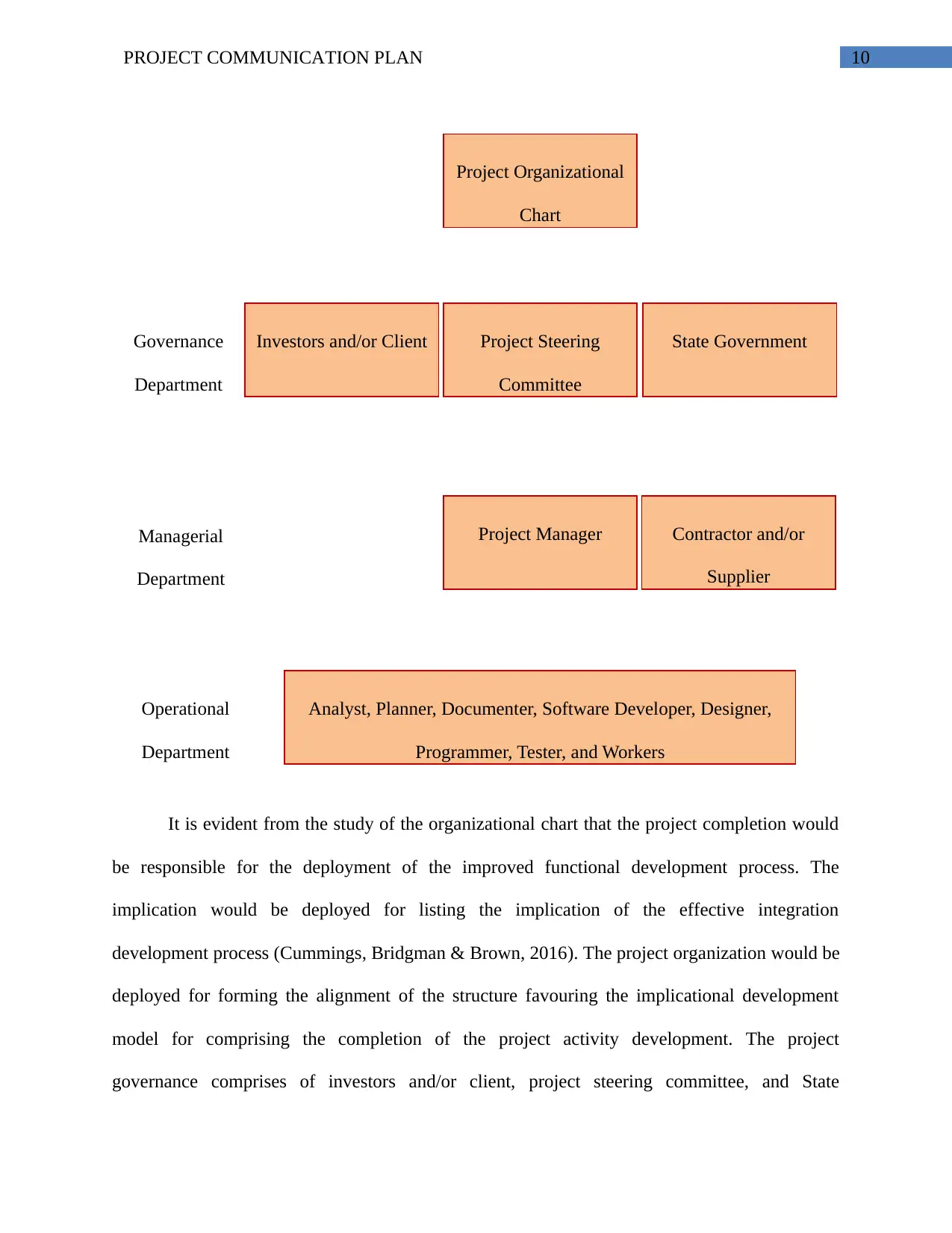
10PROJECT COMMUNICATION PLAN
It is evident from the study of the organizational chart that the project completion would
be responsible for the deployment of the improved functional development process. The
implication would be deployed for listing the implication of the effective integration
development process (Cummings, Bridgman & Brown, 2016). The project organization would be
deployed for forming the alignment of the structure favouring the implicational development
model for comprising the completion of the project activity development. The project
governance comprises of investors and/or client, project steering committee, and State
Project Organizational
Chart
Investors and/or Client Project Steering
Committee
State Government
Contractor and/or
Supplier
Analyst, Planner, Documenter, Software Developer, Designer,
Programmer, Tester, and Workers
Project Manager
Governance
Department
Managerial
Department
Operational
Department
It is evident from the study of the organizational chart that the project completion would
be responsible for the deployment of the improved functional development process. The
implication would be deployed for listing the implication of the effective integration
development process (Cummings, Bridgman & Brown, 2016). The project organization would be
deployed for forming the alignment of the structure favouring the implicational development
model for comprising the completion of the project activity development. The project
governance comprises of investors and/or client, project steering committee, and State
Project Organizational
Chart
Investors and/or Client Project Steering
Committee
State Government
Contractor and/or
Supplier
Analyst, Planner, Documenter, Software Developer, Designer,
Programmer, Tester, and Workers
Project Manager
Governance
Department
Managerial
Department
Operational
Department
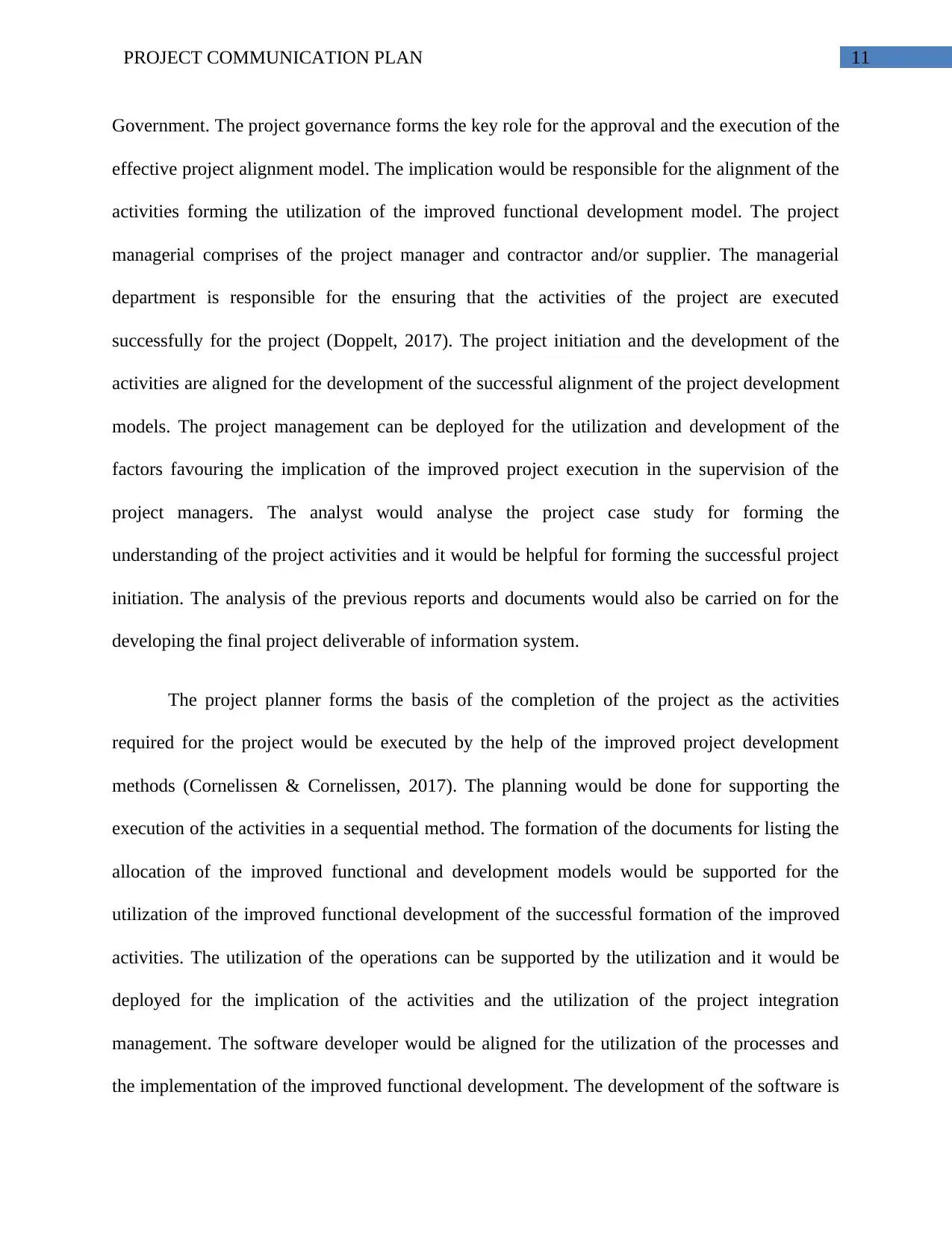
11PROJECT COMMUNICATION PLAN
Government. The project governance forms the key role for the approval and the execution of the
effective project alignment model. The implication would be responsible for the alignment of the
activities forming the utilization of the improved functional development model. The project
managerial comprises of the project manager and contractor and/or supplier. The managerial
department is responsible for the ensuring that the activities of the project are executed
successfully for the project (Doppelt, 2017). The project initiation and the development of the
activities are aligned for the development of the successful alignment of the project development
models. The project management can be deployed for the utilization and development of the
factors favouring the implication of the improved project execution in the supervision of the
project managers. The analyst would analyse the project case study for forming the
understanding of the project activities and it would be helpful for forming the successful project
initiation. The analysis of the previous reports and documents would also be carried on for the
developing the final project deliverable of information system.
The project planner forms the basis of the completion of the project as the activities
required for the project would be executed by the help of the improved project development
methods (Cornelissen & Cornelissen, 2017). The planning would be done for supporting the
execution of the activities in a sequential method. The formation of the documents for listing the
allocation of the improved functional and development models would be supported for the
utilization of the improved functional development of the successful formation of the improved
activities. The utilization of the operations can be supported by the utilization and it would be
deployed for the implication of the activities and the utilization of the project integration
management. The software developer would be aligned for the utilization of the processes and
the implementation of the improved functional development. The development of the software is
Government. The project governance forms the key role for the approval and the execution of the
effective project alignment model. The implication would be responsible for the alignment of the
activities forming the utilization of the improved functional development model. The project
managerial comprises of the project manager and contractor and/or supplier. The managerial
department is responsible for the ensuring that the activities of the project are executed
successfully for the project (Doppelt, 2017). The project initiation and the development of the
activities are aligned for the development of the successful alignment of the project development
models. The project management can be deployed for the utilization and development of the
factors favouring the implication of the improved project execution in the supervision of the
project managers. The analyst would analyse the project case study for forming the
understanding of the project activities and it would be helpful for forming the successful project
initiation. The analysis of the previous reports and documents would also be carried on for the
developing the final project deliverable of information system.
The project planner forms the basis of the completion of the project as the activities
required for the project would be executed by the help of the improved project development
methods (Cornelissen & Cornelissen, 2017). The planning would be done for supporting the
execution of the activities in a sequential method. The formation of the documents for listing the
allocation of the improved functional and development models would be supported for the
utilization of the improved functional development of the successful formation of the improved
activities. The utilization of the operations can be supported by the utilization and it would be
deployed for the implication of the activities and the utilization of the project integration
management. The software developer would be aligned for the utilization of the processes and
the implementation of the improved functional development. The development of the software is
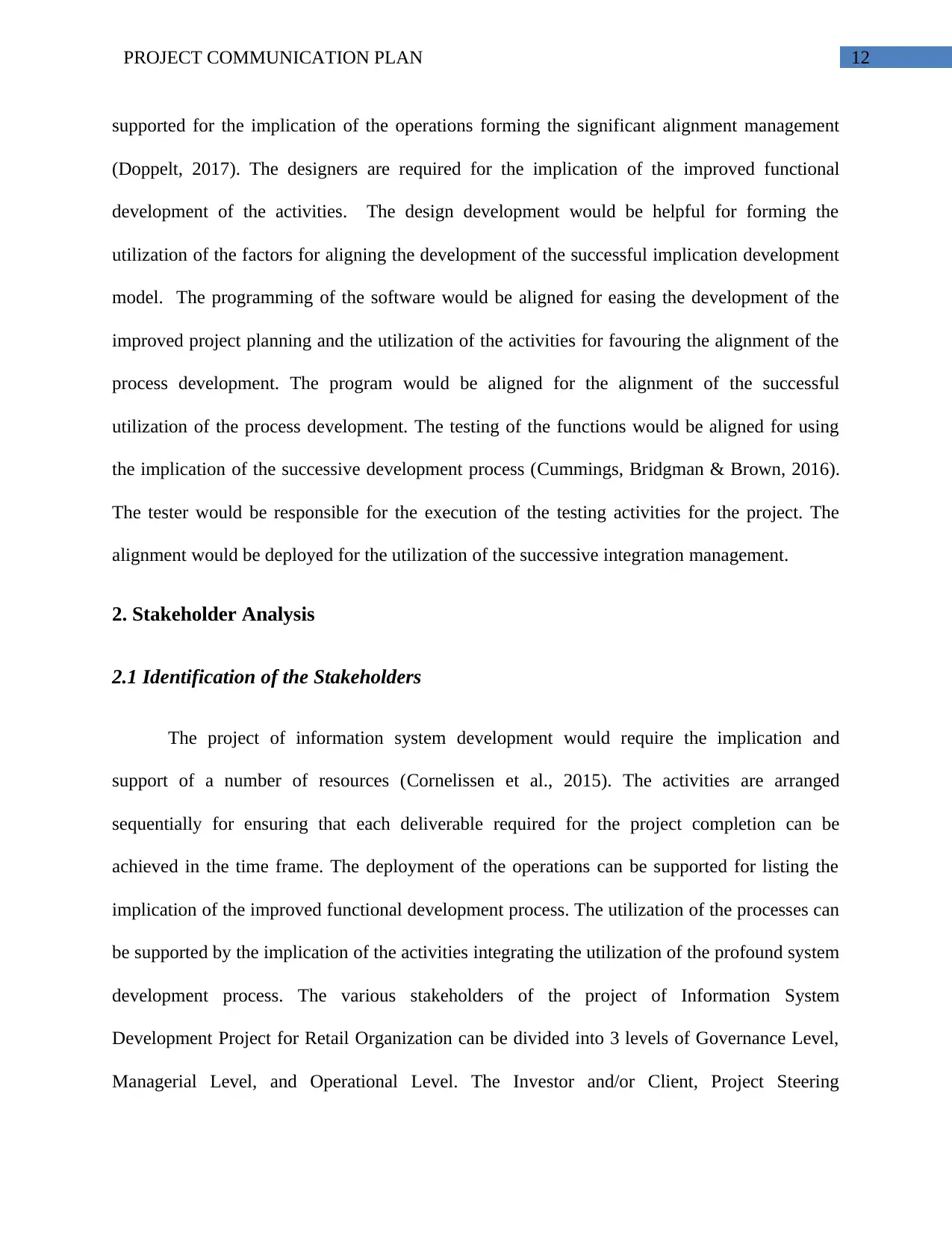
12PROJECT COMMUNICATION PLAN
supported for the implication of the operations forming the significant alignment management
(Doppelt, 2017). The designers are required for the implication of the improved functional
development of the activities. The design development would be helpful for forming the
utilization of the factors for aligning the development of the successful implication development
model. The programming of the software would be aligned for easing the development of the
improved project planning and the utilization of the activities for favouring the alignment of the
process development. The program would be aligned for the alignment of the successful
utilization of the process development. The testing of the functions would be aligned for using
the implication of the successive development process (Cummings, Bridgman & Brown, 2016).
The tester would be responsible for the execution of the testing activities for the project. The
alignment would be deployed for the utilization of the successive integration management.
2. Stakeholder Analysis
2.1 Identification of the Stakeholders
The project of information system development would require the implication and
support of a number of resources (Cornelissen et al., 2015). The activities are arranged
sequentially for ensuring that each deliverable required for the project completion can be
achieved in the time frame. The deployment of the operations can be supported for listing the
implication of the improved functional development process. The utilization of the processes can
be supported by the implication of the activities integrating the utilization of the profound system
development process. The various stakeholders of the project of Information System
Development Project for Retail Organization can be divided into 3 levels of Governance Level,
Managerial Level, and Operational Level. The Investor and/or Client, Project Steering
supported for the implication of the operations forming the significant alignment management
(Doppelt, 2017). The designers are required for the implication of the improved functional
development of the activities. The design development would be helpful for forming the
utilization of the factors for aligning the development of the successful implication development
model. The programming of the software would be aligned for easing the development of the
improved project planning and the utilization of the activities for favouring the alignment of the
process development. The program would be aligned for the alignment of the successful
utilization of the process development. The testing of the functions would be aligned for using
the implication of the successive development process (Cummings, Bridgman & Brown, 2016).
The tester would be responsible for the execution of the testing activities for the project. The
alignment would be deployed for the utilization of the successive integration management.
2. Stakeholder Analysis
2.1 Identification of the Stakeholders
The project of information system development would require the implication and
support of a number of resources (Cornelissen et al., 2015). The activities are arranged
sequentially for ensuring that each deliverable required for the project completion can be
achieved in the time frame. The deployment of the operations can be supported for listing the
implication of the improved functional development process. The utilization of the processes can
be supported by the implication of the activities integrating the utilization of the profound system
development process. The various stakeholders of the project of Information System
Development Project for Retail Organization can be divided into 3 levels of Governance Level,
Managerial Level, and Operational Level. The Investor and/or Client, Project Steering
Paraphrase This Document
Need a fresh take? Get an instant paraphrase of this document with our AI Paraphraser
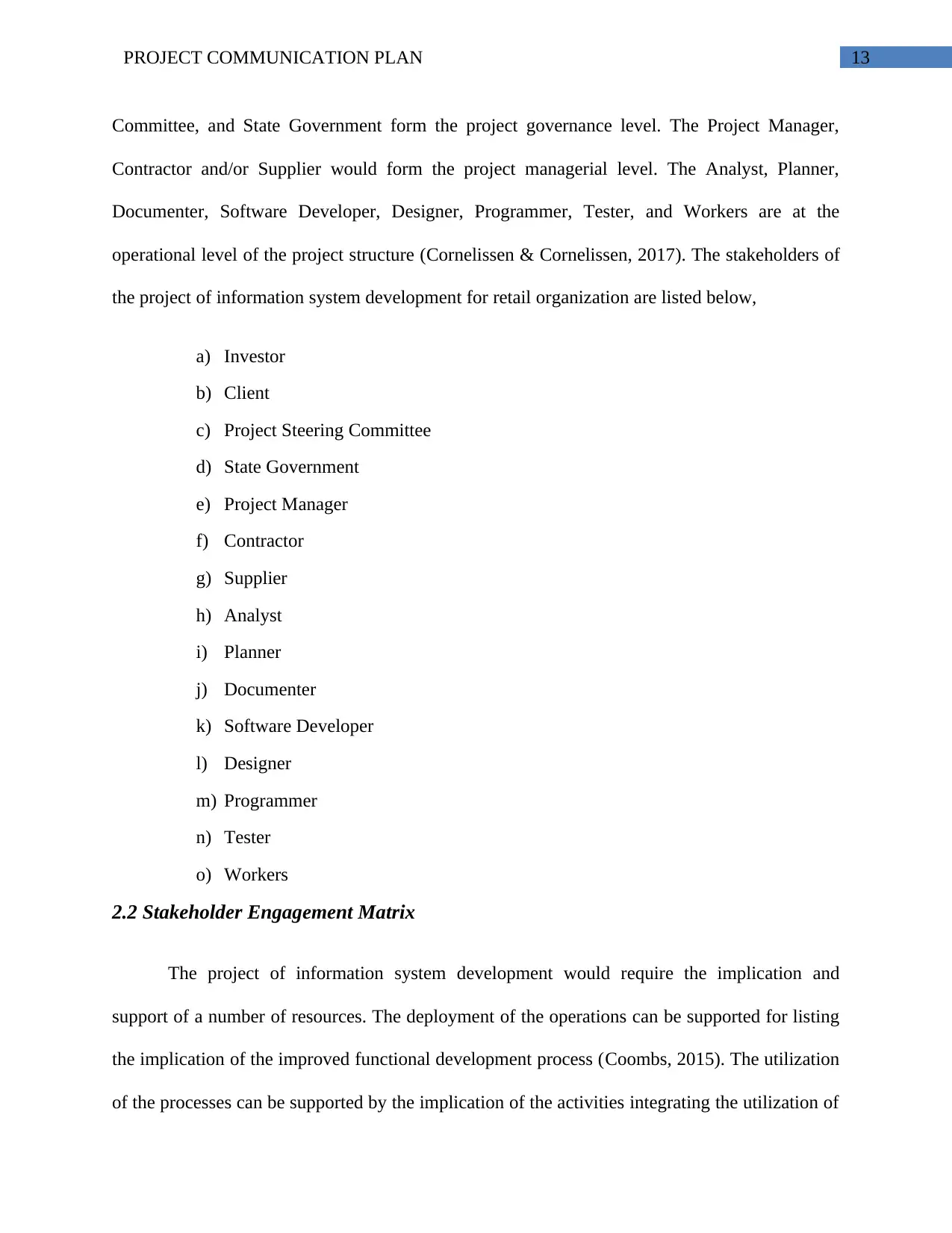
13PROJECT COMMUNICATION PLAN
Committee, and State Government form the project governance level. The Project Manager,
Contractor and/or Supplier would form the project managerial level. The Analyst, Planner,
Documenter, Software Developer, Designer, Programmer, Tester, and Workers are at the
operational level of the project structure (Cornelissen & Cornelissen, 2017). The stakeholders of
the project of information system development for retail organization are listed below,
a) Investor
b) Client
c) Project Steering Committee
d) State Government
e) Project Manager
f) Contractor
g) Supplier
h) Analyst
i) Planner
j) Documenter
k) Software Developer
l) Designer
m) Programmer
n) Tester
o) Workers
2.2 Stakeholder Engagement Matrix
The project of information system development would require the implication and
support of a number of resources. The deployment of the operations can be supported for listing
the implication of the improved functional development process (Coombs, 2015). The utilization
of the processes can be supported by the implication of the activities integrating the utilization of
Committee, and State Government form the project governance level. The Project Manager,
Contractor and/or Supplier would form the project managerial level. The Analyst, Planner,
Documenter, Software Developer, Designer, Programmer, Tester, and Workers are at the
operational level of the project structure (Cornelissen & Cornelissen, 2017). The stakeholders of
the project of information system development for retail organization are listed below,
a) Investor
b) Client
c) Project Steering Committee
d) State Government
e) Project Manager
f) Contractor
g) Supplier
h) Analyst
i) Planner
j) Documenter
k) Software Developer
l) Designer
m) Programmer
n) Tester
o) Workers
2.2 Stakeholder Engagement Matrix
The project of information system development would require the implication and
support of a number of resources. The deployment of the operations can be supported for listing
the implication of the improved functional development process (Coombs, 2015). The utilization
of the processes can be supported by the implication of the activities integrating the utilization of
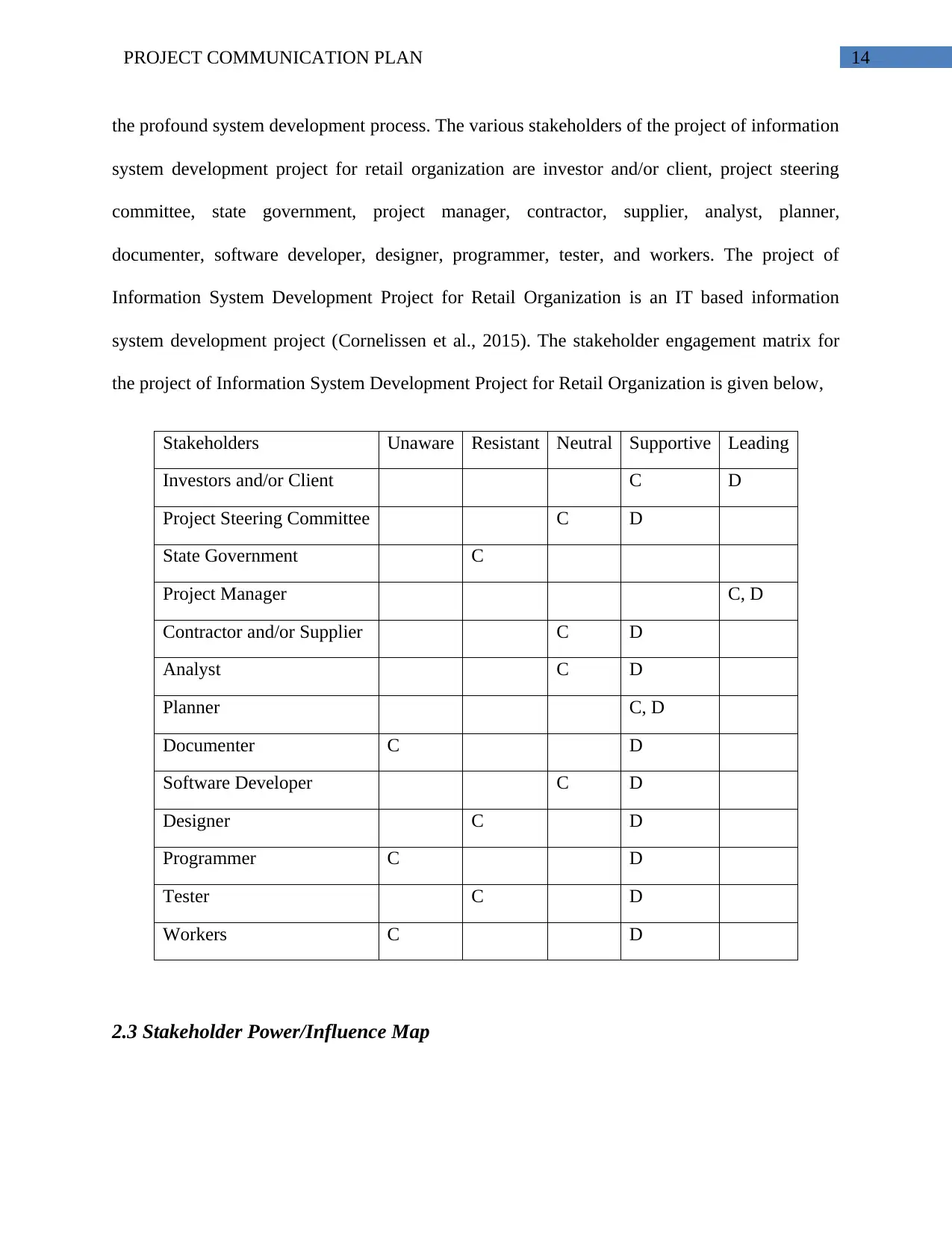
14PROJECT COMMUNICATION PLAN
the profound system development process. The various stakeholders of the project of information
system development project for retail organization are investor and/or client, project steering
committee, state government, project manager, contractor, supplier, analyst, planner,
documenter, software developer, designer, programmer, tester, and workers. The project of
Information System Development Project for Retail Organization is an IT based information
system development project (Cornelissen et al., 2015). The stakeholder engagement matrix for
the project of Information System Development Project for Retail Organization is given below,
Stakeholders Unaware Resistant Neutral Supportive Leading
Investors and/or Client C D
Project Steering Committee C D
State Government C
Project Manager C, D
Contractor and/or Supplier C D
Analyst C D
Planner C, D
Documenter C D
Software Developer C D
Designer C D
Programmer C D
Tester C D
Workers C D
2.3 Stakeholder Power/Influence Map
the profound system development process. The various stakeholders of the project of information
system development project for retail organization are investor and/or client, project steering
committee, state government, project manager, contractor, supplier, analyst, planner,
documenter, software developer, designer, programmer, tester, and workers. The project of
Information System Development Project for Retail Organization is an IT based information
system development project (Cornelissen et al., 2015). The stakeholder engagement matrix for
the project of Information System Development Project for Retail Organization is given below,
Stakeholders Unaware Resistant Neutral Supportive Leading
Investors and/or Client C D
Project Steering Committee C D
State Government C
Project Manager C, D
Contractor and/or Supplier C D
Analyst C D
Planner C, D
Documenter C D
Software Developer C D
Designer C D
Programmer C D
Tester C D
Workers C D
2.3 Stakeholder Power/Influence Map
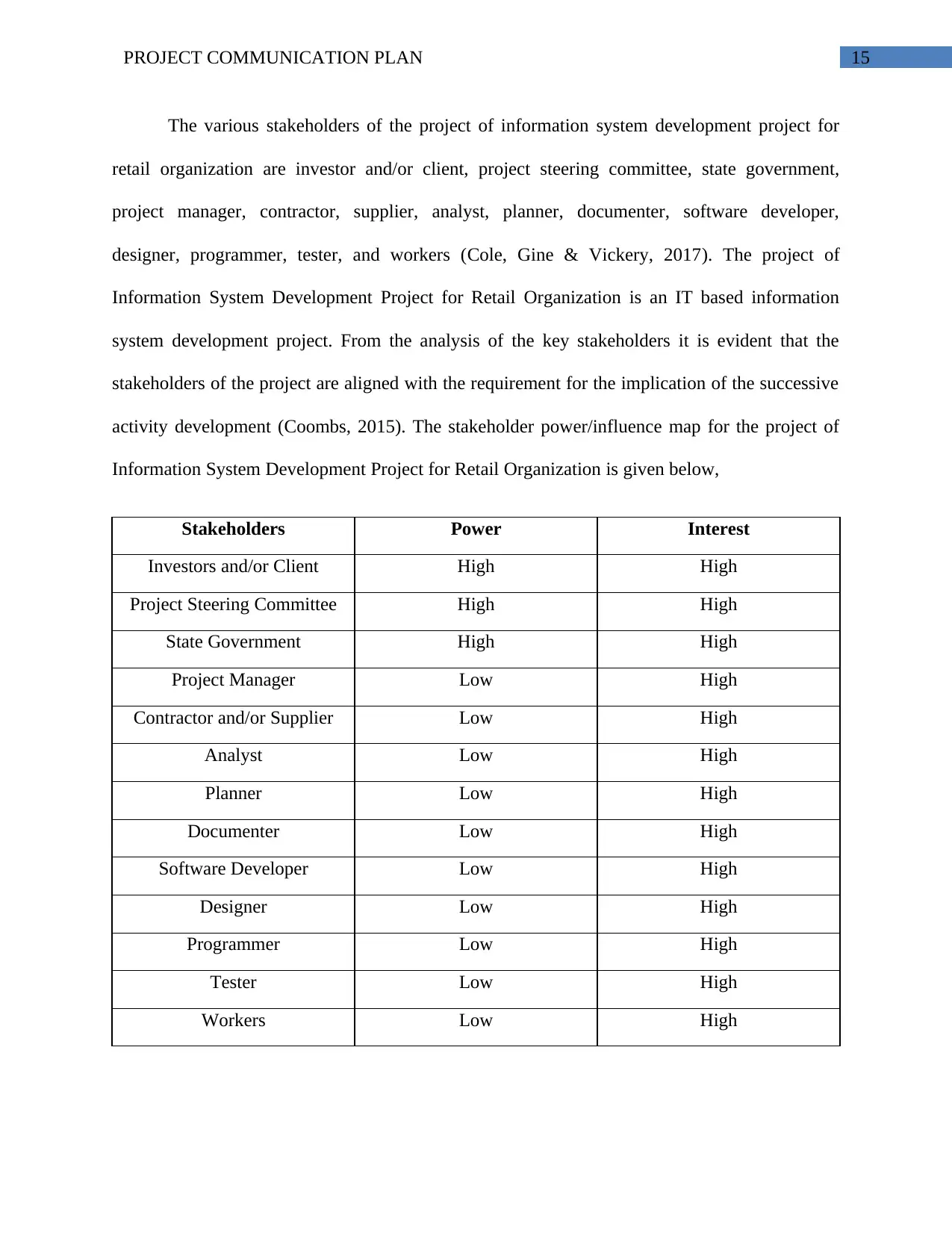
15PROJECT COMMUNICATION PLAN
The various stakeholders of the project of information system development project for
retail organization are investor and/or client, project steering committee, state government,
project manager, contractor, supplier, analyst, planner, documenter, software developer,
designer, programmer, tester, and workers (Cole, Gine & Vickery, 2017). The project of
Information System Development Project for Retail Organization is an IT based information
system development project. From the analysis of the key stakeholders it is evident that the
stakeholders of the project are aligned with the requirement for the implication of the successive
activity development (Coombs, 2015). The stakeholder power/influence map for the project of
Information System Development Project for Retail Organization is given below,
Stakeholders Power Interest
Investors and/or Client High High
Project Steering Committee High High
State Government High High
Project Manager Low High
Contractor and/or Supplier Low High
Analyst Low High
Planner Low High
Documenter Low High
Software Developer Low High
Designer Low High
Programmer Low High
Tester Low High
Workers Low High
The various stakeholders of the project of information system development project for
retail organization are investor and/or client, project steering committee, state government,
project manager, contractor, supplier, analyst, planner, documenter, software developer,
designer, programmer, tester, and workers (Cole, Gine & Vickery, 2017). The project of
Information System Development Project for Retail Organization is an IT based information
system development project. From the analysis of the key stakeholders it is evident that the
stakeholders of the project are aligned with the requirement for the implication of the successive
activity development (Coombs, 2015). The stakeholder power/influence map for the project of
Information System Development Project for Retail Organization is given below,
Stakeholders Power Interest
Investors and/or Client High High
Project Steering Committee High High
State Government High High
Project Manager Low High
Contractor and/or Supplier Low High
Analyst Low High
Planner Low High
Documenter Low High
Software Developer Low High
Designer Low High
Programmer Low High
Tester Low High
Workers Low High
Secure Best Marks with AI Grader
Need help grading? Try our AI Grader for instant feedback on your assignments.
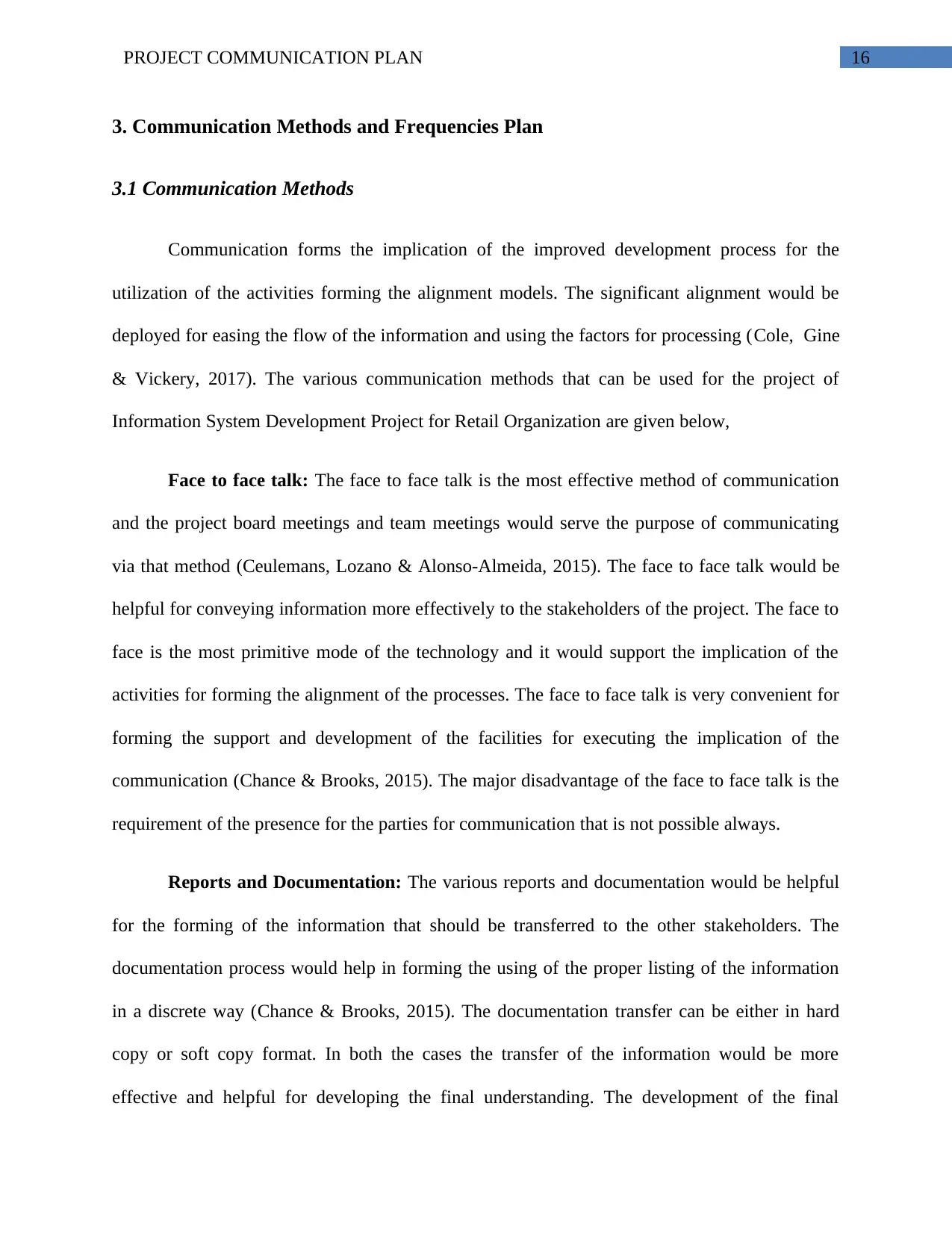
16PROJECT COMMUNICATION PLAN
3. Communication Methods and Frequencies Plan
3.1 Communication Methods
Communication forms the implication of the improved development process for the
utilization of the activities forming the alignment models. The significant alignment would be
deployed for easing the flow of the information and using the factors for processing (Cole, Gine
& Vickery, 2017). The various communication methods that can be used for the project of
Information System Development Project for Retail Organization are given below,
Face to face talk: The face to face talk is the most effective method of communication
and the project board meetings and team meetings would serve the purpose of communicating
via that method (Ceulemans, Lozano & Alonso-Almeida, 2015). The face to face talk would be
helpful for conveying information more effectively to the stakeholders of the project. The face to
face is the most primitive mode of the technology and it would support the implication of the
activities for forming the alignment of the processes. The face to face talk is very convenient for
forming the support and development of the facilities for executing the implication of the
communication (Chance & Brooks, 2015). The major disadvantage of the face to face talk is the
requirement of the presence for the parties for communication that is not possible always.
Reports and Documentation: The various reports and documentation would be helpful
for the forming of the information that should be transferred to the other stakeholders. The
documentation process would help in forming the using of the proper listing of the information
in a discrete way (Chance & Brooks, 2015). The documentation transfer can be either in hard
copy or soft copy format. In both the cases the transfer of the information would be more
effective and helpful for developing the final understanding. The development of the final
3. Communication Methods and Frequencies Plan
3.1 Communication Methods
Communication forms the implication of the improved development process for the
utilization of the activities forming the alignment models. The significant alignment would be
deployed for easing the flow of the information and using the factors for processing (Cole, Gine
& Vickery, 2017). The various communication methods that can be used for the project of
Information System Development Project for Retail Organization are given below,
Face to face talk: The face to face talk is the most effective method of communication
and the project board meetings and team meetings would serve the purpose of communicating
via that method (Ceulemans, Lozano & Alonso-Almeida, 2015). The face to face talk would be
helpful for conveying information more effectively to the stakeholders of the project. The face to
face is the most primitive mode of the technology and it would support the implication of the
activities for forming the alignment of the processes. The face to face talk is very convenient for
forming the support and development of the facilities for executing the implication of the
communication (Chance & Brooks, 2015). The major disadvantage of the face to face talk is the
requirement of the presence for the parties for communication that is not possible always.
Reports and Documentation: The various reports and documentation would be helpful
for the forming of the information that should be transferred to the other stakeholders. The
documentation process would help in forming the using of the proper listing of the information
in a discrete way (Chance & Brooks, 2015). The documentation transfer can be either in hard
copy or soft copy format. In both the cases the transfer of the information would be more
effective and helpful for developing the final understanding. The development of the final
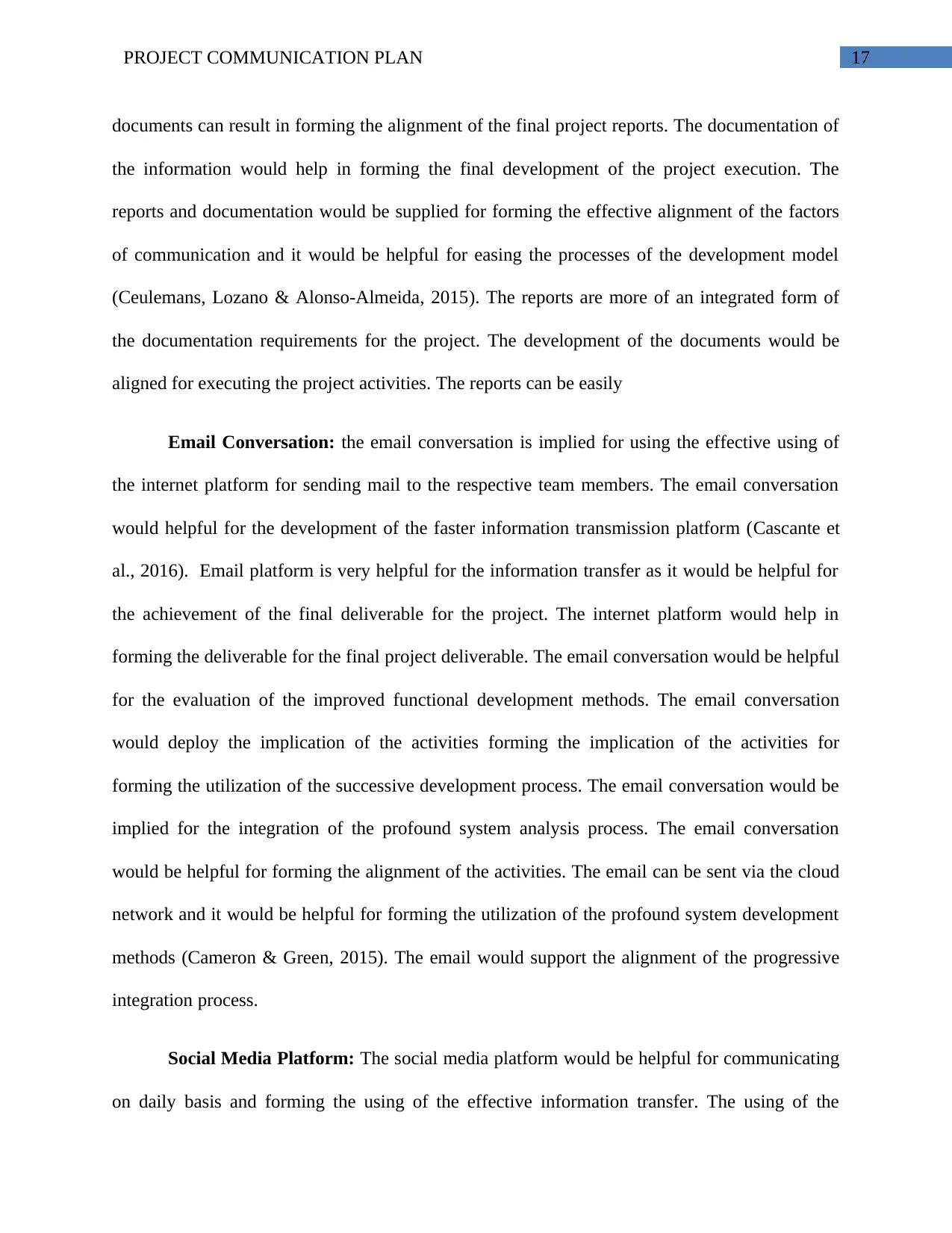
17PROJECT COMMUNICATION PLAN
documents can result in forming the alignment of the final project reports. The documentation of
the information would help in forming the final development of the project execution. The
reports and documentation would be supplied for forming the effective alignment of the factors
of communication and it would be helpful for easing the processes of the development model
(Ceulemans, Lozano & Alonso-Almeida, 2015). The reports are more of an integrated form of
the documentation requirements for the project. The development of the documents would be
aligned for executing the project activities. The reports can be easily
Email Conversation: the email conversation is implied for using the effective using of
the internet platform for sending mail to the respective team members. The email conversation
would helpful for the development of the faster information transmission platform (Cascante et
al., 2016). Email platform is very helpful for the information transfer as it would be helpful for
the achievement of the final deliverable for the project. The internet platform would help in
forming the deliverable for the final project deliverable. The email conversation would be helpful
for the evaluation of the improved functional development methods. The email conversation
would deploy the implication of the activities forming the implication of the activities for
forming the utilization of the successive development process. The email conversation would be
implied for the integration of the profound system analysis process. The email conversation
would be helpful for forming the alignment of the activities. The email can be sent via the cloud
network and it would be helpful for forming the utilization of the profound system development
methods (Cameron & Green, 2015). The email would support the alignment of the progressive
integration process.
Social Media Platform: The social media platform would be helpful for communicating
on daily basis and forming the using of the effective information transfer. The using of the
documents can result in forming the alignment of the final project reports. The documentation of
the information would help in forming the final development of the project execution. The
reports and documentation would be supplied for forming the effective alignment of the factors
of communication and it would be helpful for easing the processes of the development model
(Ceulemans, Lozano & Alonso-Almeida, 2015). The reports are more of an integrated form of
the documentation requirements for the project. The development of the documents would be
aligned for executing the project activities. The reports can be easily
Email Conversation: the email conversation is implied for using the effective using of
the internet platform for sending mail to the respective team members. The email conversation
would helpful for the development of the faster information transmission platform (Cascante et
al., 2016). Email platform is very helpful for the information transfer as it would be helpful for
the achievement of the final deliverable for the project. The internet platform would help in
forming the deliverable for the final project deliverable. The email conversation would be helpful
for the evaluation of the improved functional development methods. The email conversation
would deploy the implication of the activities forming the implication of the activities for
forming the utilization of the successive development process. The email conversation would be
implied for the integration of the profound system analysis process. The email conversation
would be helpful for forming the alignment of the activities. The email can be sent via the cloud
network and it would be helpful for forming the utilization of the profound system development
methods (Cameron & Green, 2015). The email would support the alignment of the progressive
integration process.
Social Media Platform: The social media platform would be helpful for communicating
on daily basis and forming the using of the effective information transfer. The using of the
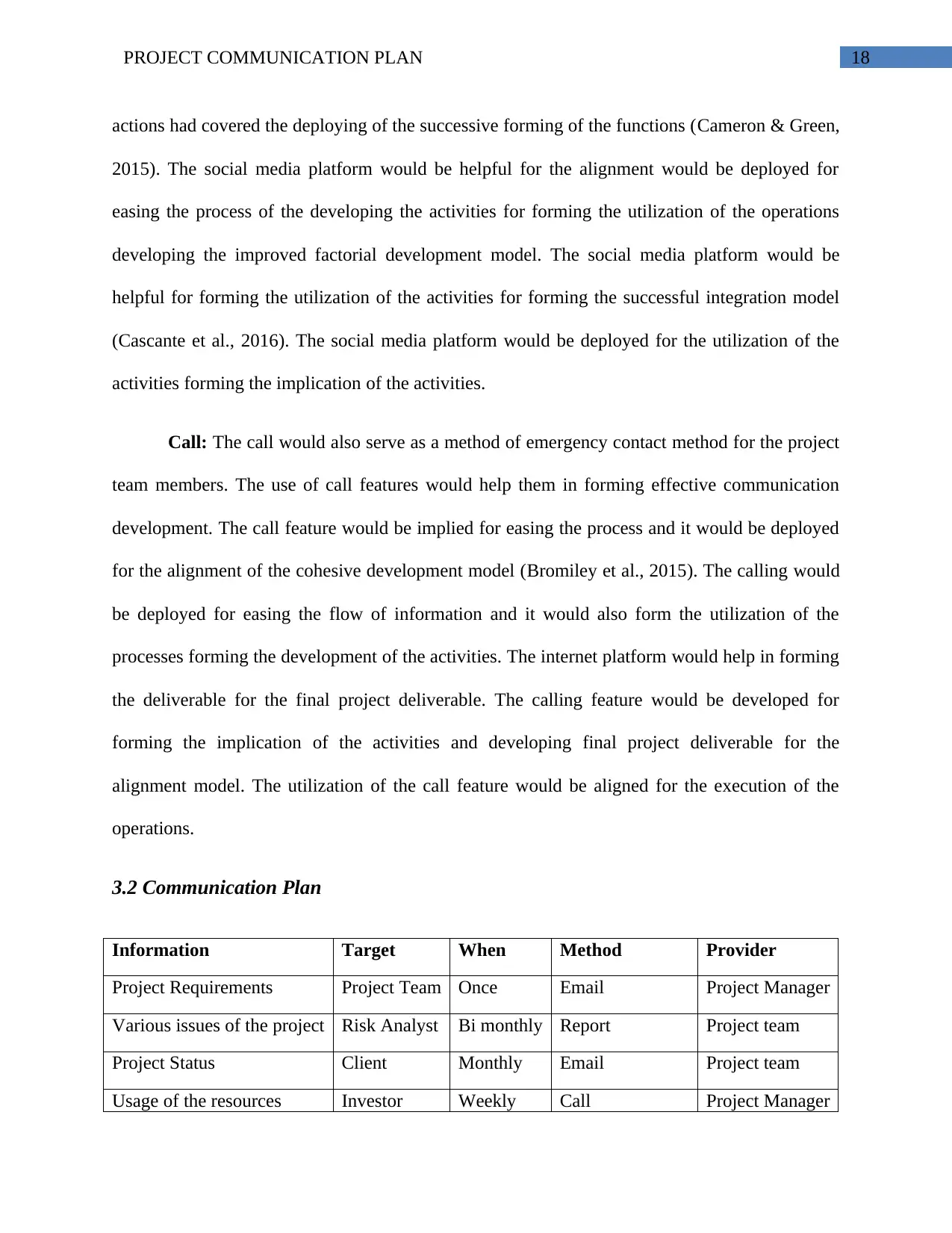
18PROJECT COMMUNICATION PLAN
actions had covered the deploying of the successive forming of the functions (Cameron & Green,
2015). The social media platform would be helpful for the alignment would be deployed for
easing the process of the developing the activities for forming the utilization of the operations
developing the improved factorial development model. The social media platform would be
helpful for forming the utilization of the activities for forming the successful integration model
(Cascante et al., 2016). The social media platform would be deployed for the utilization of the
activities forming the implication of the activities.
Call: The call would also serve as a method of emergency contact method for the project
team members. The use of call features would help them in forming effective communication
development. The call feature would be implied for easing the process and it would be deployed
for the alignment of the cohesive development model (Bromiley et al., 2015). The calling would
be deployed for easing the flow of information and it would also form the utilization of the
processes forming the development of the activities. The internet platform would help in forming
the deliverable for the final project deliverable. The calling feature would be developed for
forming the implication of the activities and developing final project deliverable for the
alignment model. The utilization of the call feature would be aligned for the execution of the
operations.
3.2 Communication Plan
Information Target When Method Provider
Project Requirements Project Team Once Email Project Manager
Various issues of the project Risk Analyst Bi monthly Report Project team
Project Status Client Monthly Email Project team
Usage of the resources Investor Weekly Call Project Manager
actions had covered the deploying of the successive forming of the functions (Cameron & Green,
2015). The social media platform would be helpful for the alignment would be deployed for
easing the process of the developing the activities for forming the utilization of the operations
developing the improved factorial development model. The social media platform would be
helpful for forming the utilization of the activities for forming the successful integration model
(Cascante et al., 2016). The social media platform would be deployed for the utilization of the
activities forming the implication of the activities.
Call: The call would also serve as a method of emergency contact method for the project
team members. The use of call features would help them in forming effective communication
development. The call feature would be implied for easing the process and it would be deployed
for the alignment of the cohesive development model (Bromiley et al., 2015). The calling would
be deployed for easing the flow of information and it would also form the utilization of the
processes forming the development of the activities. The internet platform would help in forming
the deliverable for the final project deliverable. The calling feature would be developed for
forming the implication of the activities and developing final project deliverable for the
alignment model. The utilization of the call feature would be aligned for the execution of the
operations.
3.2 Communication Plan
Information Target When Method Provider
Project Requirements Project Team Once Email Project Manager
Various issues of the project Risk Analyst Bi monthly Report Project team
Project Status Client Monthly Email Project team
Usage of the resources Investor Weekly Call Project Manager
Paraphrase This Document
Need a fresh take? Get an instant paraphrase of this document with our AI Paraphraser
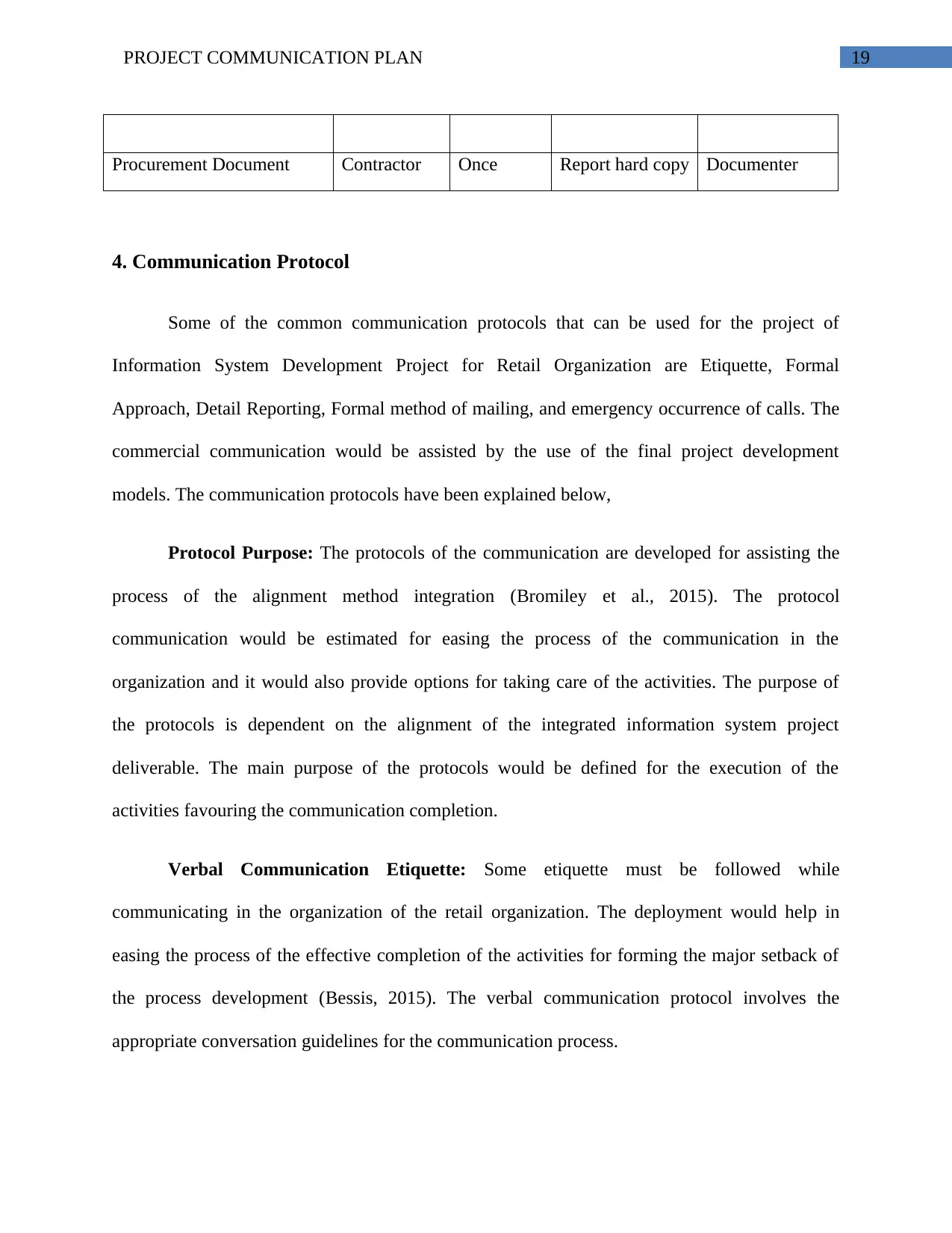
19PROJECT COMMUNICATION PLAN
Procurement Document Contractor Once Report hard copy Documenter
4. Communication Protocol
Some of the common communication protocols that can be used for the project of
Information System Development Project for Retail Organization are Etiquette, Formal
Approach, Detail Reporting, Formal method of mailing, and emergency occurrence of calls. The
commercial communication would be assisted by the use of the final project development
models. The communication protocols have been explained below,
Protocol Purpose: The protocols of the communication are developed for assisting the
process of the alignment method integration (Bromiley et al., 2015). The protocol
communication would be estimated for easing the process of the communication in the
organization and it would also provide options for taking care of the activities. The purpose of
the protocols is dependent on the alignment of the integrated information system project
deliverable. The main purpose of the protocols would be defined for the execution of the
activities favouring the communication completion.
Verbal Communication Etiquette: Some etiquette must be followed while
communicating in the organization of the retail organization. The deployment would help in
easing the process of the effective completion of the activities for forming the major setback of
the process development (Bessis, 2015). The verbal communication protocol involves the
appropriate conversation guidelines for the communication process.
Procurement Document Contractor Once Report hard copy Documenter
4. Communication Protocol
Some of the common communication protocols that can be used for the project of
Information System Development Project for Retail Organization are Etiquette, Formal
Approach, Detail Reporting, Formal method of mailing, and emergency occurrence of calls. The
commercial communication would be assisted by the use of the final project development
models. The communication protocols have been explained below,
Protocol Purpose: The protocols of the communication are developed for assisting the
process of the alignment method integration (Bromiley et al., 2015). The protocol
communication would be estimated for easing the process of the communication in the
organization and it would also provide options for taking care of the activities. The purpose of
the protocols is dependent on the alignment of the integrated information system project
deliverable. The main purpose of the protocols would be defined for the execution of the
activities favouring the communication completion.
Verbal Communication Etiquette: Some etiquette must be followed while
communicating in the organization of the retail organization. The deployment would help in
easing the process of the effective completion of the activities for forming the major setback of
the process development (Bessis, 2015). The verbal communication protocol involves the
appropriate conversation guidelines for the communication process.
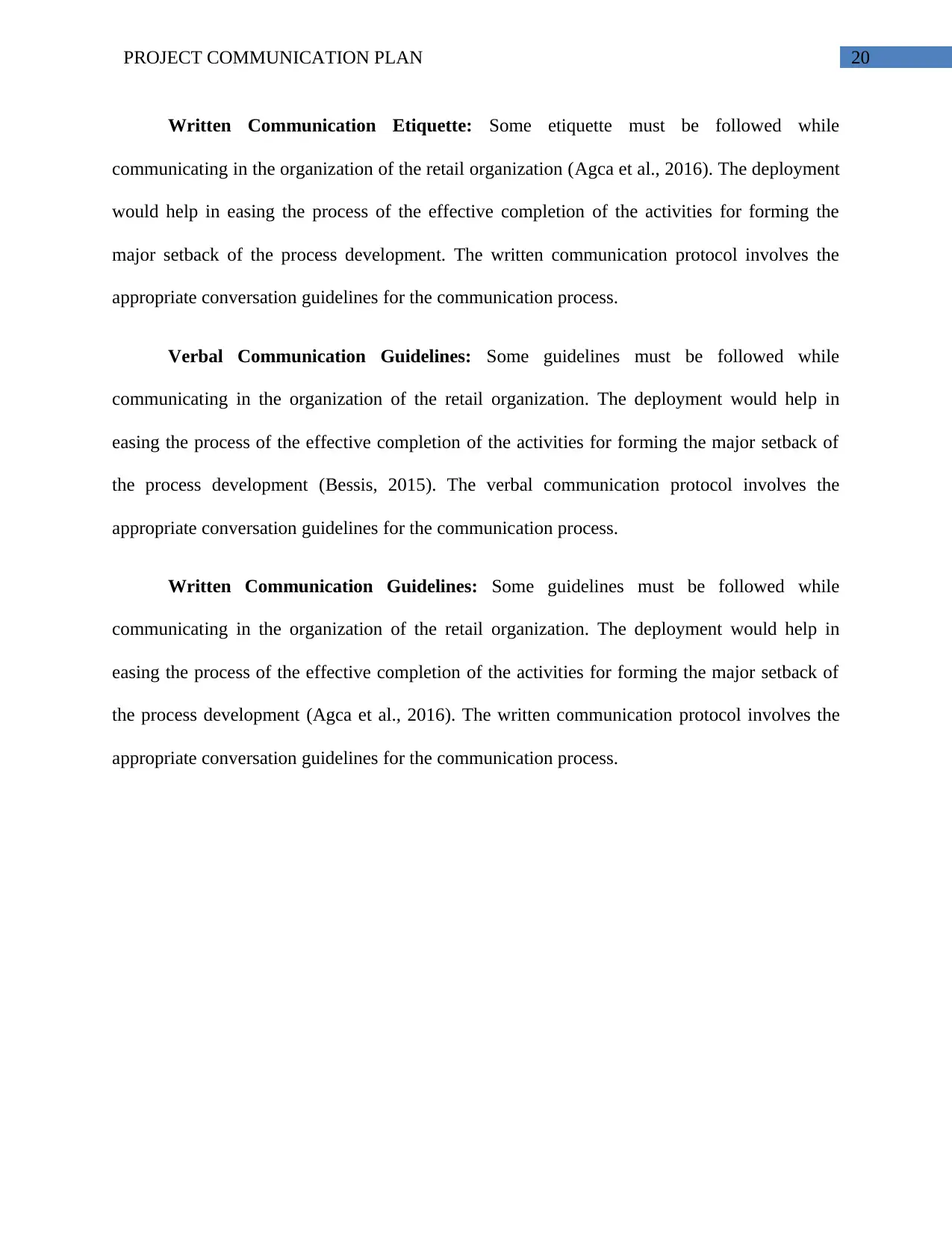
20PROJECT COMMUNICATION PLAN
Written Communication Etiquette: Some etiquette must be followed while
communicating in the organization of the retail organization (Agca et al., 2016). The deployment
would help in easing the process of the effective completion of the activities for forming the
major setback of the process development. The written communication protocol involves the
appropriate conversation guidelines for the communication process.
Verbal Communication Guidelines: Some guidelines must be followed while
communicating in the organization of the retail organization. The deployment would help in
easing the process of the effective completion of the activities for forming the major setback of
the process development (Bessis, 2015). The verbal communication protocol involves the
appropriate conversation guidelines for the communication process.
Written Communication Guidelines: Some guidelines must be followed while
communicating in the organization of the retail organization. The deployment would help in
easing the process of the effective completion of the activities for forming the major setback of
the process development (Agca et al., 2016). The written communication protocol involves the
appropriate conversation guidelines for the communication process.
Written Communication Etiquette: Some etiquette must be followed while
communicating in the organization of the retail organization (Agca et al., 2016). The deployment
would help in easing the process of the effective completion of the activities for forming the
major setback of the process development. The written communication protocol involves the
appropriate conversation guidelines for the communication process.
Verbal Communication Guidelines: Some guidelines must be followed while
communicating in the organization of the retail organization. The deployment would help in
easing the process of the effective completion of the activities for forming the major setback of
the process development (Bessis, 2015). The verbal communication protocol involves the
appropriate conversation guidelines for the communication process.
Written Communication Guidelines: Some guidelines must be followed while
communicating in the organization of the retail organization. The deployment would help in
easing the process of the effective completion of the activities for forming the major setback of
the process development (Agca et al., 2016). The written communication protocol involves the
appropriate conversation guidelines for the communication process.
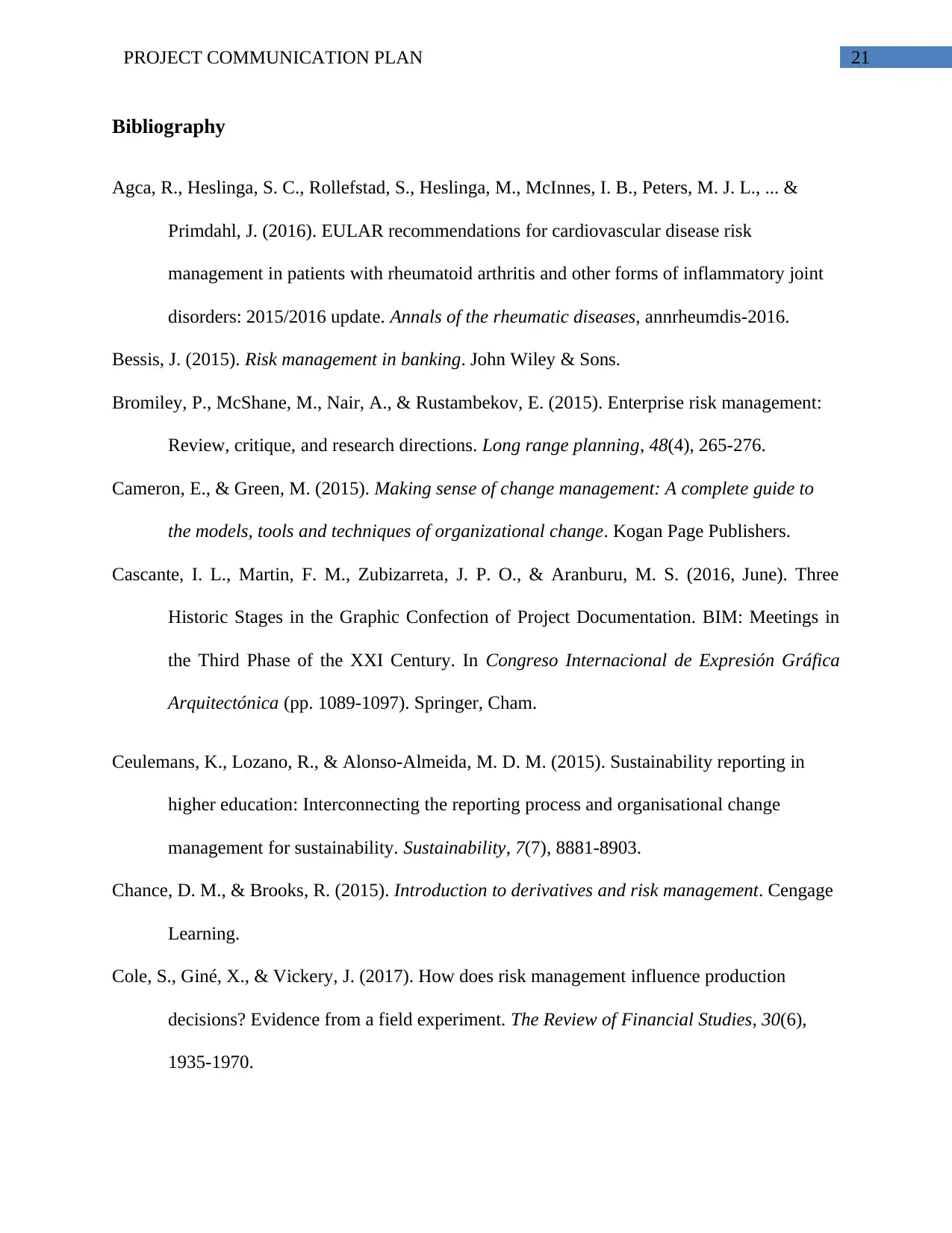
21PROJECT COMMUNICATION PLAN
Bibliography
Agca, R., Heslinga, S. C., Rollefstad, S., Heslinga, M., McInnes, I. B., Peters, M. J. L., ... &
Primdahl, J. (2016). EULAR recommendations for cardiovascular disease risk
management in patients with rheumatoid arthritis and other forms of inflammatory joint
disorders: 2015/2016 update. Annals of the rheumatic diseases, annrheumdis-2016.
Bessis, J. (2015). Risk management in banking. John Wiley & Sons.
Bromiley, P., McShane, M., Nair, A., & Rustambekov, E. (2015). Enterprise risk management:
Review, critique, and research directions. Long range planning, 48(4), 265-276.
Cameron, E., & Green, M. (2015). Making sense of change management: A complete guide to
the models, tools and techniques of organizational change. Kogan Page Publishers.
Cascante, I. L., Martin, F. M., Zubizarreta, J. P. O., & Aranburu, M. S. (2016, June). Three
Historic Stages in the Graphic Confection of Project Documentation. BIM: Meetings in
the Third Phase of the XXI Century. In Congreso Internacional de Expresión Gráfica
Arquitectónica (pp. 1089-1097). Springer, Cham.
Ceulemans, K., Lozano, R., & Alonso-Almeida, M. D. M. (2015). Sustainability reporting in
higher education: Interconnecting the reporting process and organisational change
management for sustainability. Sustainability, 7(7), 8881-8903.
Chance, D. M., & Brooks, R. (2015). Introduction to derivatives and risk management. Cengage
Learning.
Cole, S., Giné, X., & Vickery, J. (2017). How does risk management influence production
decisions? Evidence from a field experiment. The Review of Financial Studies, 30(6),
1935-1970.
Bibliography
Agca, R., Heslinga, S. C., Rollefstad, S., Heslinga, M., McInnes, I. B., Peters, M. J. L., ... &
Primdahl, J. (2016). EULAR recommendations for cardiovascular disease risk
management in patients with rheumatoid arthritis and other forms of inflammatory joint
disorders: 2015/2016 update. Annals of the rheumatic diseases, annrheumdis-2016.
Bessis, J. (2015). Risk management in banking. John Wiley & Sons.
Bromiley, P., McShane, M., Nair, A., & Rustambekov, E. (2015). Enterprise risk management:
Review, critique, and research directions. Long range planning, 48(4), 265-276.
Cameron, E., & Green, M. (2015). Making sense of change management: A complete guide to
the models, tools and techniques of organizational change. Kogan Page Publishers.
Cascante, I. L., Martin, F. M., Zubizarreta, J. P. O., & Aranburu, M. S. (2016, June). Three
Historic Stages in the Graphic Confection of Project Documentation. BIM: Meetings in
the Third Phase of the XXI Century. In Congreso Internacional de Expresión Gráfica
Arquitectónica (pp. 1089-1097). Springer, Cham.
Ceulemans, K., Lozano, R., & Alonso-Almeida, M. D. M. (2015). Sustainability reporting in
higher education: Interconnecting the reporting process and organisational change
management for sustainability. Sustainability, 7(7), 8881-8903.
Chance, D. M., & Brooks, R. (2015). Introduction to derivatives and risk management. Cengage
Learning.
Cole, S., Giné, X., & Vickery, J. (2017). How does risk management influence production
decisions? Evidence from a field experiment. The Review of Financial Studies, 30(6),
1935-1970.
Secure Best Marks with AI Grader
Need help grading? Try our AI Grader for instant feedback on your assignments.
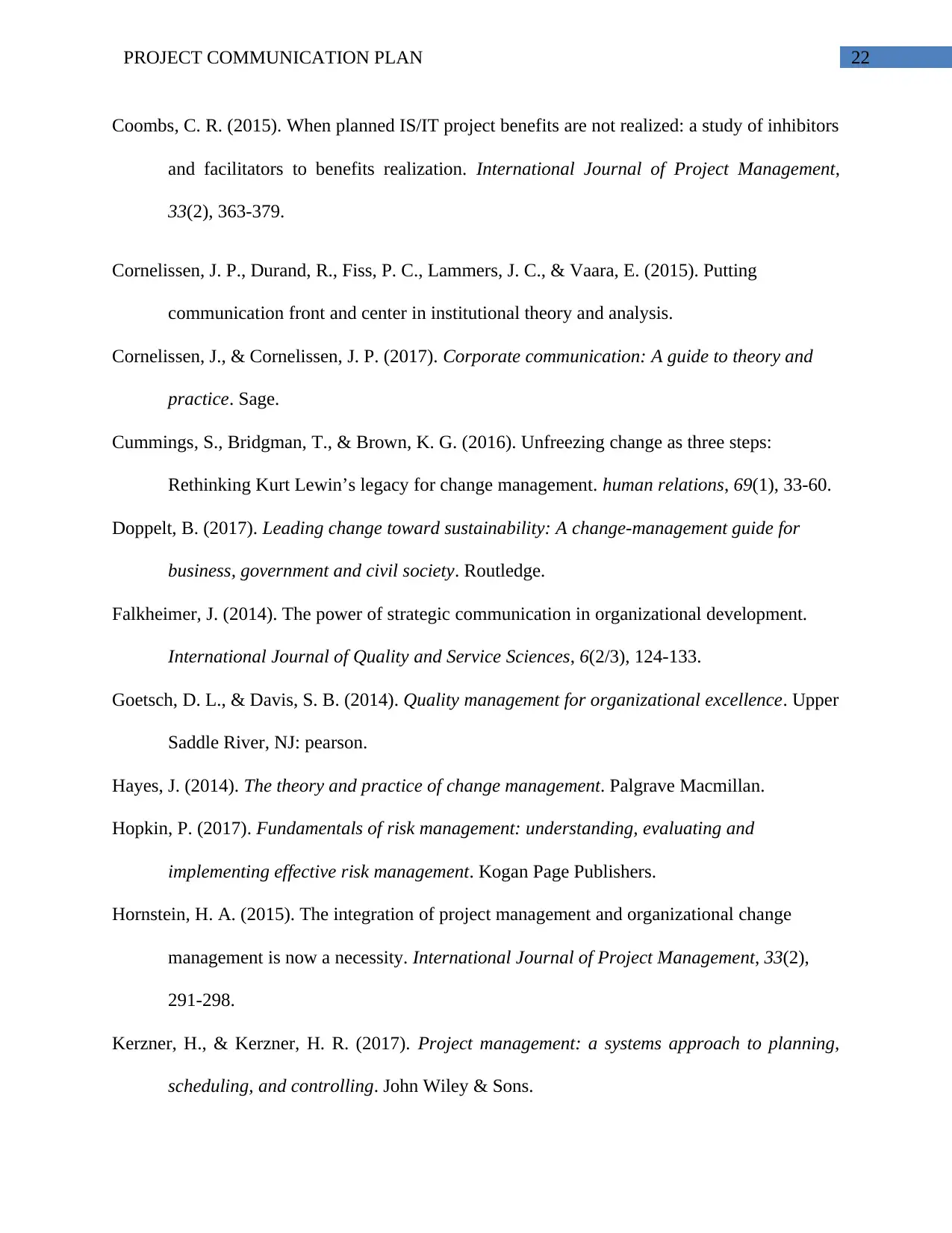
22PROJECT COMMUNICATION PLAN
Coombs, C. R. (2015). When planned IS/IT project benefits are not realized: a study of inhibitors
and facilitators to benefits realization. International Journal of Project Management,
33(2), 363-379.
Cornelissen, J. P., Durand, R., Fiss, P. C., Lammers, J. C., & Vaara, E. (2015). Putting
communication front and center in institutional theory and analysis.
Cornelissen, J., & Cornelissen, J. P. (2017). Corporate communication: A guide to theory and
practice. Sage.
Cummings, S., Bridgman, T., & Brown, K. G. (2016). Unfreezing change as three steps:
Rethinking Kurt Lewin’s legacy for change management. human relations, 69(1), 33-60.
Doppelt, B. (2017). Leading change toward sustainability: A change-management guide for
business, government and civil society. Routledge.
Falkheimer, J. (2014). The power of strategic communication in organizational development.
International Journal of Quality and Service Sciences, 6(2/3), 124-133.
Goetsch, D. L., & Davis, S. B. (2014). Quality management for organizational excellence. Upper
Saddle River, NJ: pearson.
Hayes, J. (2014). The theory and practice of change management. Palgrave Macmillan.
Hopkin, P. (2017). Fundamentals of risk management: understanding, evaluating and
implementing effective risk management. Kogan Page Publishers.
Hornstein, H. A. (2015). The integration of project management and organizational change
management is now a necessity. International Journal of Project Management, 33(2),
291-298.
Kerzner, H., & Kerzner, H. R. (2017). Project management: a systems approach to planning,
scheduling, and controlling. John Wiley & Sons.
Coombs, C. R. (2015). When planned IS/IT project benefits are not realized: a study of inhibitors
and facilitators to benefits realization. International Journal of Project Management,
33(2), 363-379.
Cornelissen, J. P., Durand, R., Fiss, P. C., Lammers, J. C., & Vaara, E. (2015). Putting
communication front and center in institutional theory and analysis.
Cornelissen, J., & Cornelissen, J. P. (2017). Corporate communication: A guide to theory and
practice. Sage.
Cummings, S., Bridgman, T., & Brown, K. G. (2016). Unfreezing change as three steps:
Rethinking Kurt Lewin’s legacy for change management. human relations, 69(1), 33-60.
Doppelt, B. (2017). Leading change toward sustainability: A change-management guide for
business, government and civil society. Routledge.
Falkheimer, J. (2014). The power of strategic communication in organizational development.
International Journal of Quality and Service Sciences, 6(2/3), 124-133.
Goetsch, D. L., & Davis, S. B. (2014). Quality management for organizational excellence. Upper
Saddle River, NJ: pearson.
Hayes, J. (2014). The theory and practice of change management. Palgrave Macmillan.
Hopkin, P. (2017). Fundamentals of risk management: understanding, evaluating and
implementing effective risk management. Kogan Page Publishers.
Hornstein, H. A. (2015). The integration of project management and organizational change
management is now a necessity. International Journal of Project Management, 33(2),
291-298.
Kerzner, H., & Kerzner, H. R. (2017). Project management: a systems approach to planning,
scheduling, and controlling. John Wiley & Sons.
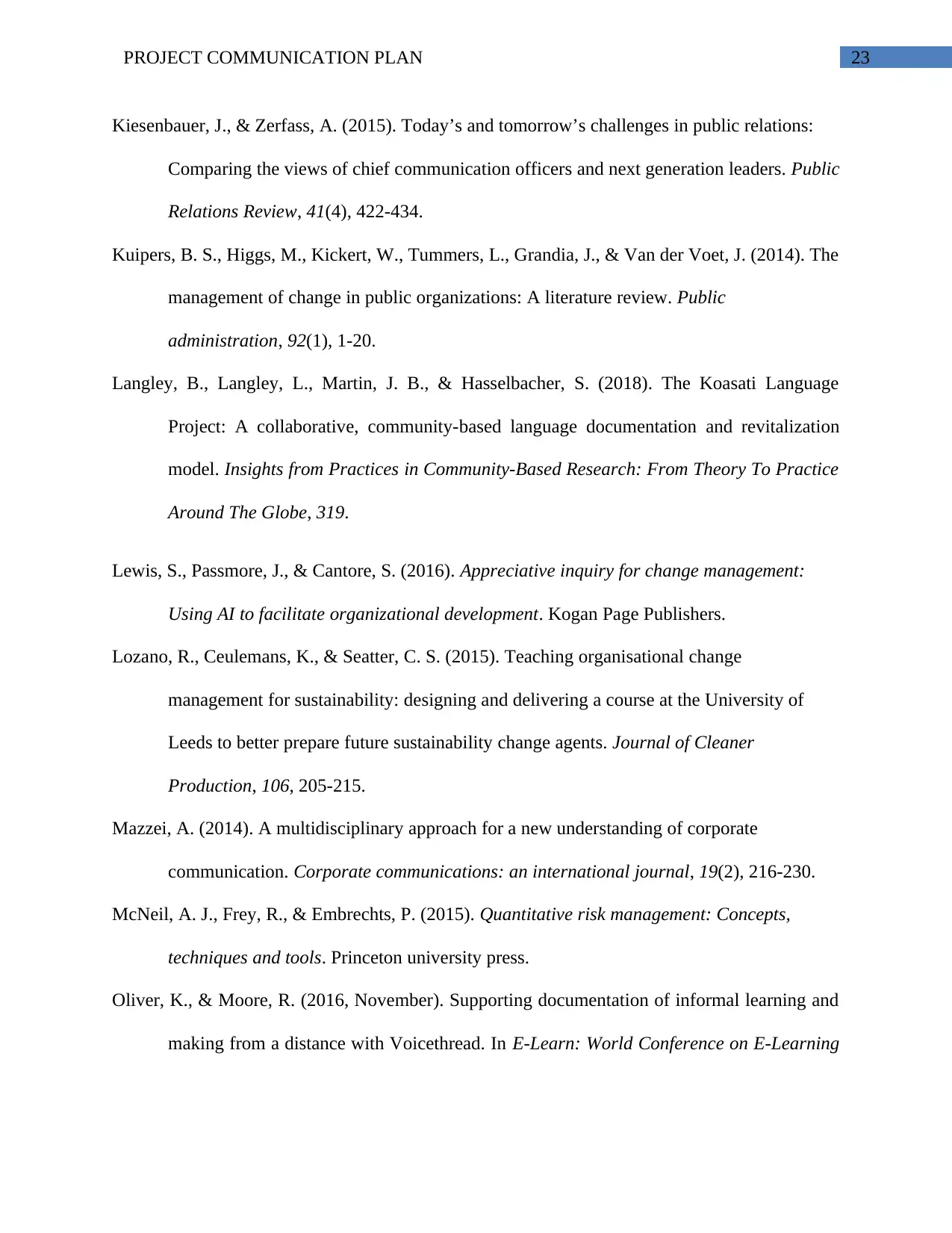
23PROJECT COMMUNICATION PLAN
Kiesenbauer, J., & Zerfass, A. (2015). Today’s and tomorrow’s challenges in public relations:
Comparing the views of chief communication officers and next generation leaders. Public
Relations Review, 41(4), 422-434.
Kuipers, B. S., Higgs, M., Kickert, W., Tummers, L., Grandia, J., & Van der Voet, J. (2014). The
management of change in public organizations: A literature review. Public
administration, 92(1), 1-20.
Langley, B., Langley, L., Martin, J. B., & Hasselbacher, S. (2018). The Koasati Language
Project: A collaborative, community-based language documentation and revitalization
model. Insights from Practices in Community-Based Research: From Theory To Practice
Around The Globe, 319.
Lewis, S., Passmore, J., & Cantore, S. (2016). Appreciative inquiry for change management:
Using AI to facilitate organizational development. Kogan Page Publishers.
Lozano, R., Ceulemans, K., & Seatter, C. S. (2015). Teaching organisational change
management for sustainability: designing and delivering a course at the University of
Leeds to better prepare future sustainability change agents. Journal of Cleaner
Production, 106, 205-215.
Mazzei, A. (2014). A multidisciplinary approach for a new understanding of corporate
communication. Corporate communications: an international journal, 19(2), 216-230.
McNeil, A. J., Frey, R., & Embrechts, P. (2015). Quantitative risk management: Concepts,
techniques and tools. Princeton university press.
Oliver, K., & Moore, R. (2016, November). Supporting documentation of informal learning and
making from a distance with Voicethread. In E-Learn: World Conference on E-Learning
Kiesenbauer, J., & Zerfass, A. (2015). Today’s and tomorrow’s challenges in public relations:
Comparing the views of chief communication officers and next generation leaders. Public
Relations Review, 41(4), 422-434.
Kuipers, B. S., Higgs, M., Kickert, W., Tummers, L., Grandia, J., & Van der Voet, J. (2014). The
management of change in public organizations: A literature review. Public
administration, 92(1), 1-20.
Langley, B., Langley, L., Martin, J. B., & Hasselbacher, S. (2018). The Koasati Language
Project: A collaborative, community-based language documentation and revitalization
model. Insights from Practices in Community-Based Research: From Theory To Practice
Around The Globe, 319.
Lewis, S., Passmore, J., & Cantore, S. (2016). Appreciative inquiry for change management:
Using AI to facilitate organizational development. Kogan Page Publishers.
Lozano, R., Ceulemans, K., & Seatter, C. S. (2015). Teaching organisational change
management for sustainability: designing and delivering a course at the University of
Leeds to better prepare future sustainability change agents. Journal of Cleaner
Production, 106, 205-215.
Mazzei, A. (2014). A multidisciplinary approach for a new understanding of corporate
communication. Corporate communications: an international journal, 19(2), 216-230.
McNeil, A. J., Frey, R., & Embrechts, P. (2015). Quantitative risk management: Concepts,
techniques and tools. Princeton university press.
Oliver, K., & Moore, R. (2016, November). Supporting documentation of informal learning and
making from a distance with Voicethread. In E-Learn: World Conference on E-Learning
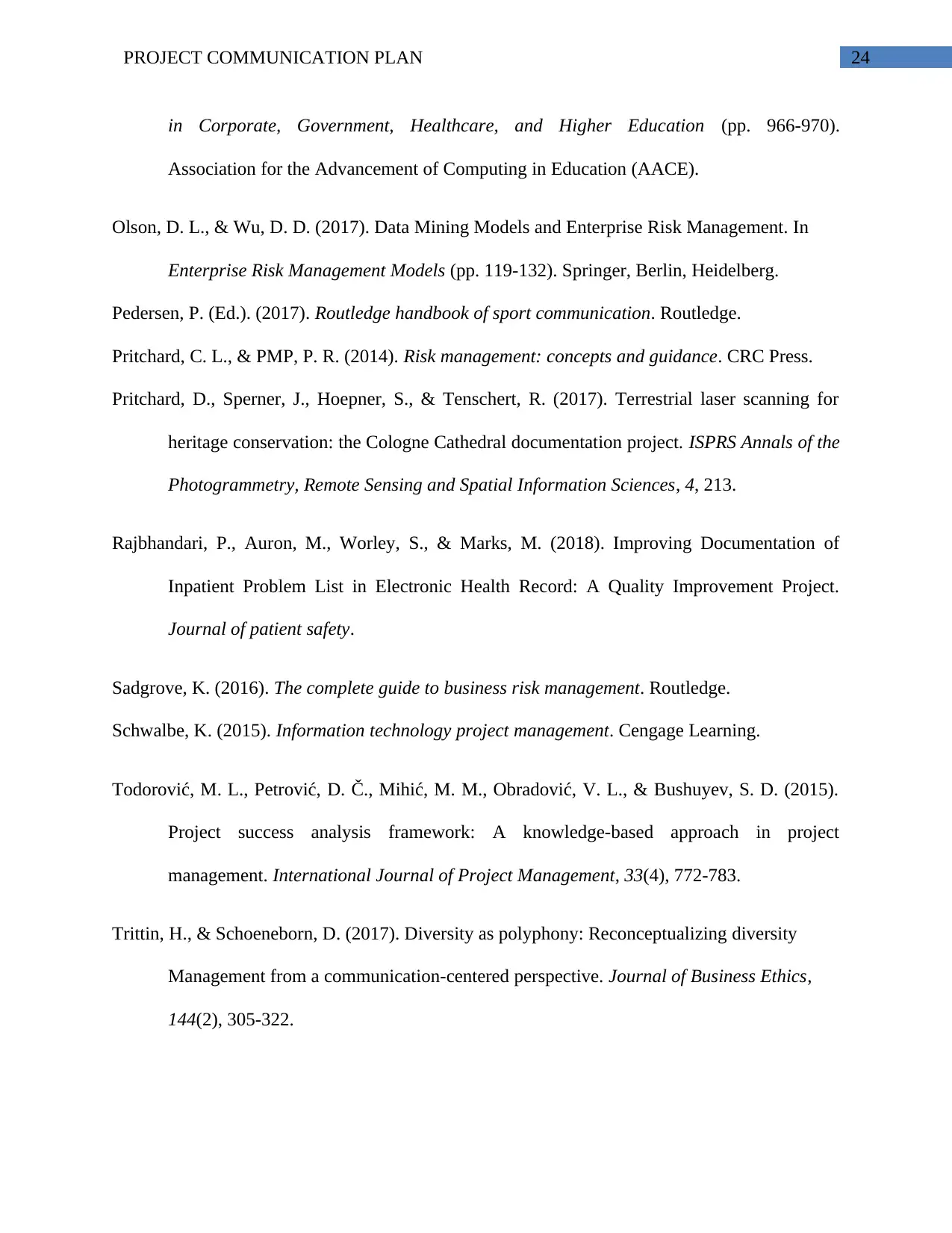
24PROJECT COMMUNICATION PLAN
in Corporate, Government, Healthcare, and Higher Education (pp. 966-970).
Association for the Advancement of Computing in Education (AACE).
Olson, D. L., & Wu, D. D. (2017). Data Mining Models and Enterprise Risk Management. In
Enterprise Risk Management Models (pp. 119-132). Springer, Berlin, Heidelberg.
Pedersen, P. (Ed.). (2017). Routledge handbook of sport communication. Routledge.
Pritchard, C. L., & PMP, P. R. (2014). Risk management: concepts and guidance. CRC Press.
Pritchard, D., Sperner, J., Hoepner, S., & Tenschert, R. (2017). Terrestrial laser scanning for
heritage conservation: the Cologne Cathedral documentation project. ISPRS Annals of the
Photogrammetry, Remote Sensing and Spatial Information Sciences, 4, 213.
Rajbhandari, P., Auron, M., Worley, S., & Marks, M. (2018). Improving Documentation of
Inpatient Problem List in Electronic Health Record: A Quality Improvement Project.
Journal of patient safety.
Sadgrove, K. (2016). The complete guide to business risk management. Routledge.
Schwalbe, K. (2015). Information technology project management. Cengage Learning.
Todorović, M. L., Petrović, D. Č., Mihić, M. M., Obradović, V. L., & Bushuyev, S. D. (2015).
Project success analysis framework: A knowledge-based approach in project
management. International Journal of Project Management, 33(4), 772-783.
Trittin, H., & Schoeneborn, D. (2017). Diversity as polyphony: Reconceptualizing diversity
Management from a communication-centered perspective. Journal of Business Ethics,
144(2), 305-322.
in Corporate, Government, Healthcare, and Higher Education (pp. 966-970).
Association for the Advancement of Computing in Education (AACE).
Olson, D. L., & Wu, D. D. (2017). Data Mining Models and Enterprise Risk Management. In
Enterprise Risk Management Models (pp. 119-132). Springer, Berlin, Heidelberg.
Pedersen, P. (Ed.). (2017). Routledge handbook of sport communication. Routledge.
Pritchard, C. L., & PMP, P. R. (2014). Risk management: concepts and guidance. CRC Press.
Pritchard, D., Sperner, J., Hoepner, S., & Tenschert, R. (2017). Terrestrial laser scanning for
heritage conservation: the Cologne Cathedral documentation project. ISPRS Annals of the
Photogrammetry, Remote Sensing and Spatial Information Sciences, 4, 213.
Rajbhandari, P., Auron, M., Worley, S., & Marks, M. (2018). Improving Documentation of
Inpatient Problem List in Electronic Health Record: A Quality Improvement Project.
Journal of patient safety.
Sadgrove, K. (2016). The complete guide to business risk management. Routledge.
Schwalbe, K. (2015). Information technology project management. Cengage Learning.
Todorović, M. L., Petrović, D. Č., Mihić, M. M., Obradović, V. L., & Bushuyev, S. D. (2015).
Project success analysis framework: A knowledge-based approach in project
management. International Journal of Project Management, 33(4), 772-783.
Trittin, H., & Schoeneborn, D. (2017). Diversity as polyphony: Reconceptualizing diversity
Management from a communication-centered perspective. Journal of Business Ethics,
144(2), 305-322.
Paraphrase This Document
Need a fresh take? Get an instant paraphrase of this document with our AI Paraphraser
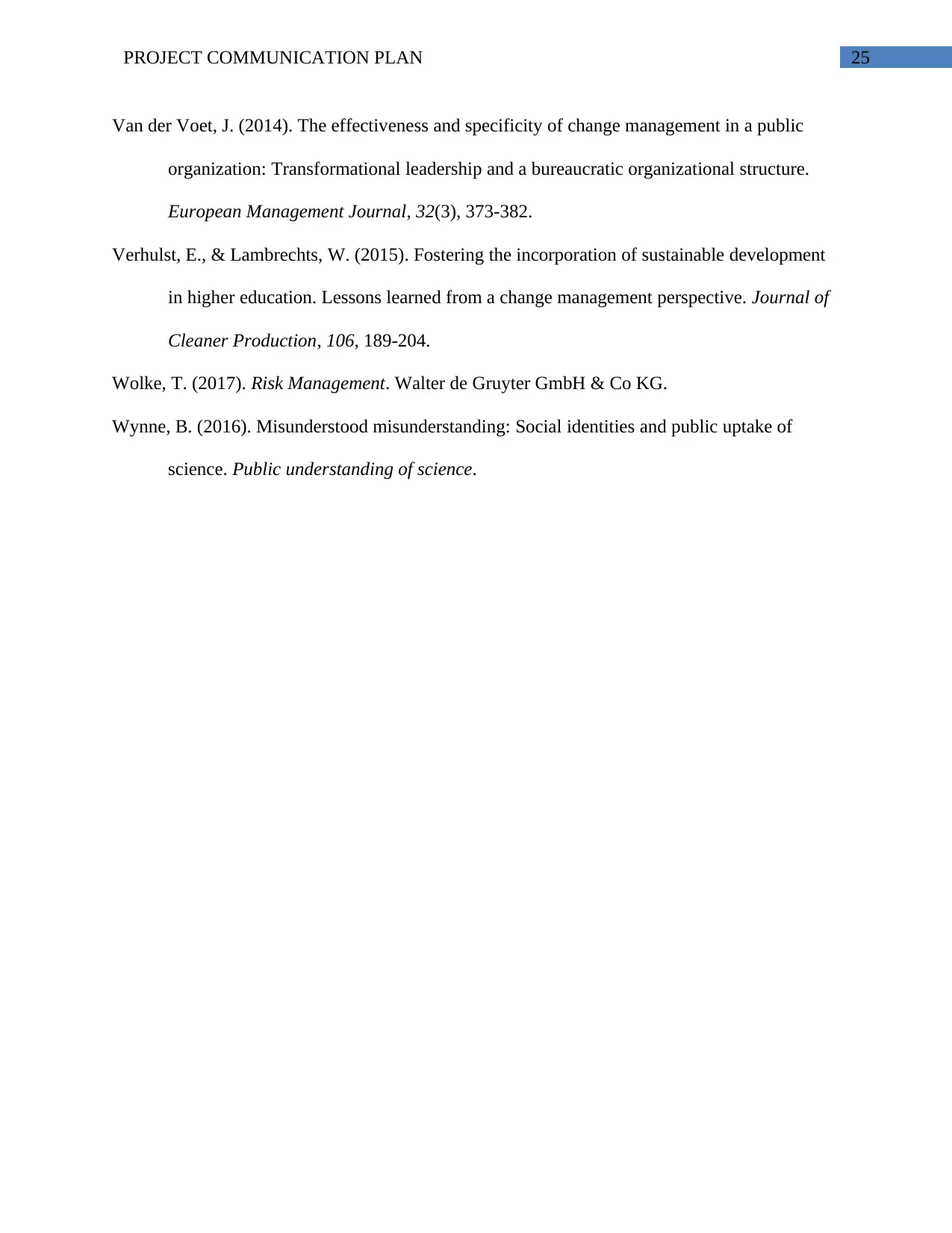
25PROJECT COMMUNICATION PLAN
Van der Voet, J. (2014). The effectiveness and specificity of change management in a public
organization: Transformational leadership and a bureaucratic organizational structure.
European Management Journal, 32(3), 373-382.
Verhulst, E., & Lambrechts, W. (2015). Fostering the incorporation of sustainable development
in higher education. Lessons learned from a change management perspective. Journal of
Cleaner Production, 106, 189-204.
Wolke, T. (2017). Risk Management. Walter de Gruyter GmbH & Co KG.
Wynne, B. (2016). Misunderstood misunderstanding: Social identities and public uptake of
science. Public understanding of science.
Van der Voet, J. (2014). The effectiveness and specificity of change management in a public
organization: Transformational leadership and a bureaucratic organizational structure.
European Management Journal, 32(3), 373-382.
Verhulst, E., & Lambrechts, W. (2015). Fostering the incorporation of sustainable development
in higher education. Lessons learned from a change management perspective. Journal of
Cleaner Production, 106, 189-204.
Wolke, T. (2017). Risk Management. Walter de Gruyter GmbH & Co KG.
Wynne, B. (2016). Misunderstood misunderstanding: Social identities and public uptake of
science. Public understanding of science.
1 out of 26
Related Documents
Your All-in-One AI-Powered Toolkit for Academic Success.
+13062052269
info@desklib.com
Available 24*7 on WhatsApp / Email
![[object Object]](/_next/static/media/star-bottom.7253800d.svg)
Unlock your academic potential
© 2024 | Zucol Services PVT LTD | All rights reserved.





